Fine Netsuke & Sagemono

SESSION I
A SELECTION OF FINE INRO
AUCTION
Friday, 3 November 2023

Fine Netsuke & Sagemono Tel +43 1 532 04 52 Fax +20 E-mail office@zacke.at www.zacke.at AUCTION Friday, 3 November 2023 CATALOG NE1123 EXHIBITION 30 October – 31 October 2023 10 am – 6 pm 2 November 2023 10 am – 6 pm as well as by appointment GALERIE ZACKE Sterngasse 13 1010 VIENNA AUSTRIA SESSION I A Selection of Fine Inro (Lots 1-62): 11 AM CET SESSION II Netsuke, Ojime & Kiseruzutsu (Lots 101-362): 1 PM CET
IMPORTANT INFORMATION
According to the general terms and conditions of business of Galerie Zacke Vienna, Founded 1968, SZA Versteigerungen & Vertriebs GmbH, 1010 Wien, online at www.zacke.at
ABSENTEE BIDDING
Absentee bids are carried out under the regulations of the terms of business of Galerie Zacke, SZA Versteigerungen & Vertriebs GmbH, which requires written submission of your purchase limit. Orders without purchase limits cannot be processed. Only the submitted lot number of the auction lot is binding for the processing of the absentee bid. The place of jurisdiction is Vienna, Austrian Law and Austrian jurisdiction are exclusively applicable for all legal questions arising from the business relationship. Absentee bids for this auction will be accepted until the day of auction by 10:00 a.m. We regret that absentee bids received after the time stated above will not be processed until after the auction.
PLEASE SEND ABSENTEE BIDS FOR THIS AUCTION TO:
Fax: +43 1 532 04 52 20 or
Email: office@zacke.at or
Mail: Galerie Zacke, Sterngasse 13, 1010 Wien, Austria, Europe
WE ACCEPT THE FOLLOWING METHODS OF PAYMENTS:
• Cash
• Certified or personal check
• Bank transfer (please inquire to receive our bank account information)
• Credit card (Visa, MasterCard, Amex)
TELEPHONE BIDDING
It is generally possible to bid by telephone during the auction. Please fill out the absentee bidding form enclosed in this catalog and include your telephone number at which you can be reached during the auction. In the “bid in euro” column please write “TEL” and then send us the completed absentee bidding form. Galerie Zacke will call you on the day of the auction, on the telephone number provided, 5 lots before the lot you are bidding on and the bidding will commence at the starting price, as stated in the catalog. If Galerie Zacke cannot reach you during the auction, Galerie Zacke will bid the starting price on your behalf.
ESTIMATES AND STARTING PRICES
The auction will begin with the starting price and written bids will be accepted only with a minimum amount equivalent to the starting price.
SHIPPING AND TRANSPORT INSURANCE

For domestic shipping Galerie Zacke (hereinafter called “the company”) charges in average Eur 15,- to Eur 50,- per item, depending on size and weight. These fees cover the costs of packing and shipping. Fees for bulky or fragile items, or international shipping will be quoted upon request.
The purchased goods are transported at the risk of the customer following handover of the packaged item to the post office or another carrier which the customer agrees to through his/her submission of the purchase order. According to the specific wish of the customer, the auctioned goods may be insured for the value of the purchase price (highest bid and all surcharges). This insurance fee is 3% of the purchase price. For any lots with a purchase prices exceeding EUR 350,- the transport insurance will be automatically arranged by the company if it does not expressively receive the purchaser’s written denial of this service and signed waiver of claims. Payments due to the company under the insurance contract will be charged to the customer. The company is also entitled to assign claims under the insurance contract to the customer providing the terms of the insurance contract do not prevent this.
In any case, the company is only required to make payment to the customer specifically if payment has effectively been received from the insurance company.
COLOR AND CONDITION
Auction lots will be exhibited for viewing prior to the auction, thus offering all interested customers the opportunity to examine the quality and condition of the works exhibited. The catalog illustrations are intended to assist customers during such preview. In illustrations, printed colors do not correspond exactly to the originals. The printed catalog images are not representative for the condition of the illustrated pieces. Hidden flaws and damages are indicated in the condition report. The illustrations in our online catalogs can be strongly magnified, so that most damages and restorations are well recognizable.
ENDANGERED SPECIES / CITES INFORMATION
Some items in this catalog may for example consist of ivory, rhinoceros-horn, tortoise shell, or some types of tropical wood, and are subject to the Convention on International Trade in Endangered Species of Wild Fauna and Flora [CITES]. Such items are marked with the symbol Ɏ on www.zacke.at and may only be exported outside the European Union after an export permit in accordance with CITES has been granted by the Austrian authorities. We would like to inform you that such licenses are typically not granted. For objects which have a low ivory content or have been proven beyond doubt to be in the EU before 1982, please contact our office for more information on how to obtain a CITES license.
COMPLAINTS
At its auctions, Galerie Zacke sells consigned lots on behalf of third-party consignors. For this reason, any complaints related to purchased lots must be in accordance with §32-48 of the general terms and conditions of business of Galerie Zacke, which can be found on www.zacke.at
IMPORTANT INFORMATION
Whenever making a bid, whether personally or via an agent, in writing, online, telephone, or in any other way, the bidder fully and unconditionally accepts the Terms of Auction, the ‘Important Information’ section in the auction catalog, the Terms and Conditions (AGB) of Galerie Zacke, §1-50, the Fee Tariff, and the Bidding Increments table, all as published on www.zacke.at on the day of the auction
THE ART LOSS REGISTER
All items starting above 2.000,- EUR have been checked by the Art Loss register.

printed according to the Austrian Ecolabel criteria for printed matter (UZ 24), UW-Nr. 715 PEFC/06-39-10 PEFC Certified This product s from sustainably managed forests and controlled sources www.pefc.at
PLEASE RAISE MY BID BY ONE BIDDING INCREMENT (ca. 10%) IF NECESSARY
IMPORTANT NOTICE:
Bids do not include buyer’s premium and VAT. Margin taxation applies. Items with added VAT are marked in the online catalog.
TELEPHONE BIDS:
ABSENTEE BIDDING FORM
FOR THE AUCTION Fine Netsuke & Sagemono NE1123
ON DATE 3 NOVEMBER 2023
PLEASE CALL ME WHEN A HIGHER BID THAN MINE HAS BEEN RECEIVED
MY PHONE NUMBER
If you like to bid by telephone, please state ‘TEL’ in the ‘BID IN EURO’ column instead of a Euro amount. Galerie Zacke will call you on the day of the auction, on the telephone number provided, 5 lots before the lot you are bidding on and the bidding will commence at the starting price, as stated in the catalog. If Galerie Zacke cannot reach you during the auction, Galerie Zacke will bid the starting price on your behalf.
TERMS OF PAYMENT, SHIPPING AND COLLECTION:
NAME
ADRESS
CITY, COUNTRY
POSTCODE
PHONE NUMBER
CREDIT CARD PAYMENT
PLEASE CHECK THE DESIRED CARD
COLLECTION BY CLIENT WITH PAYMENT ON THE PREMISES IN CASH, BY CERTIFIED CHEQUE OR CREDIT CARD
INVOICE PAYMENT
VIA BANK WIRE AFTER RECEIPT OF INVOICE SHIPPING AFTER RECEIPT OF PAYMENT
EXPRESS PARCEL SERVICE
REQUIRED (ACCORDING TO TERMS AND CONDITIONS OF GALERIE ZACKE)
SHIPPING INSURANCE
REQUIRED (ACCORDING TO TERMS AND CONDITIONS OF GALERIE ZACKE)
GALERIE ZACKE
Sterngasse 13, 1010 Vienna, Austria
Email: office@zacke.at
Tel: +43-1-532 04 52
Fax: +43-1-532 04 52 20
With the signature on this form, the client instructs the auctioneer to bid on his behalf. The Euro amount up to which the auctioneer shall bid on behalf of the client is either stated in this form or will be communicated to the auctioneer via telephone during the auction. All absentee bidding shall be governed by the terms and conditions [AGB] of Galerie Zacke. The client agrees with his signature that he has read, understood and fully accepted the AGB of Galerie Zacke. Galerie Zacke, founded 1968, is a registered brand of SZA Versteigerungen & Vertriebs GmbH, Vienna, Austria.
NAME
ADDRESS CARD NUMBER
EXPIRY DATE
IMPORTANT NOTICE:
Whenever making a bid, whether personally or via an agent, in writing, online, telephone, or in any other way, the bidder fully and unconditionally accepts the Terms of Auction, the ‘Important Information’ section in the auction catalog, the Terms and Conditions (AGB) of Galerie Zacke, §1-48, the Fee Tariff, and the Bidding Increments table, all as published on www.zacke.at on the day of the auction.
EMAIL DATE & SIGNATURE
CODE
NR.
TITLE BID IN EURO
SECURITY
LOT
LOT
MASTERCARD VISA AMEX
ABSENTEE BIDDING FORM FOR THE AUCTION Fine Netsuke & Sagemono NE1123
ON DATE 3 NOVEMBER 2023
Further images of all lots at www.zacke.at
BID IN
LOT NR. LOT TITLE
EURO
§ 1) The auction shall be carried out in accordance with the provisions of the rules of procedure of GALERIE ZACKE©, SZA VERSTEIGERUNGEN UND VERTRIEBS GMBH, Sterngasse 13, 1010 WIEN (hereinafter referred to as the company) as well as in accordance with sections 244-246 of the GEWERBEORDNUNG [Industrial Code] of 1994. The auction shall be carried out on commission. The auctioneer shall be entitled to withdraw lots exceptionally, to conduct the auction deviating from the order of the catalog numbers and to offer lots jointly. In the event of any dispute concerning a double bid or if the auctioneer has missed a bid, the auctioneer shall be entitled to revoke acceptance of a bid and to continue auctioning the item. The figures stated in the catalog shall be the highest bid in Euro (€) expected by the respective expert. As a rule, the bid shall be increased by 10% of the last bid. (See table of the bidding increments).
§ 2) The acceptance of a bid shall be granted to the highest bidder unless a hidden reserve has been agreed upon with the consignor of the item in question. Such a hidden reserve (also called limit or just reserve) shall be the minimum price under which the item will not be sold during the auction. This reserve will be disclosed upon request and after the auction only and may exceed the estimate. The auctioneer will in this case bid on behalf of the seller against all other bidders until the reserve has been reached. If a reserve is not reached during the auction, the auctioneer will knock down the item to the highest bidder at the final bid, but the sale will be conditional of the acceptance of this final bid by the seller. In this case the highest bidder shall be bound to his/her last bid for a term of 8 days starting with the day of the knockdown. If the winning bidder does not receive a written cancellation notice within this term of 8 days, the knockdown becomes unconditional and the sale is final. Typically, only a minority of all items in an auction have a hidden reserve.
§ 3) Most items shall be subject to differential taxation. A uniform surcharge of 25% plus the value added tax applicable to the surcharge to the amount of 20% shall be added to the achieved highest bid (final and highest bid). Thus, the surcharge shall be 30% of the final and highest bid in total. Items with added VAT are marked † in the online catalog.
§ 4) In the event of sales abroad, the value added tax will be repaid if the item is sold to a country which is not a member country of the European Union (third country), the legal requirements are met, and the proof of exportation is provided. The value added tax shall not be shown separately on the invoice.
§ 5) The auction buyer must pay the purchase price immediately upon acceptance of the bid (final and highest bid plus 25% surcharge, plus the value added tax applicable to the surcharge to the amount of 20%, or the added VAT on top of the final price, when a lot is highlighted accordingly in the auction catalog). The company may grant an auction buyer a term of payment for the purchase price in whole or in part when this has been formally applied for in writing before the auction.
§ 6) In the event of a term of payment, or any payment delay, in whole or in part, the company shall be entitled to charge default interest (12% p.a.) as well as storage charges (2.4% pf the final and highest bid per month commenced) after 14 days upon acceptance of the bid. The item purchased at auction shall be handed over exclusively upon full payment of the purchase price including all costs and charges accrued since the acceptance of the bid.
§ 7) The buyer should take acquired items into possession, as far as possible, immediately or after the end of the auction. Items which have been fully paid for shall be handed over in our show rooms in GALERIE ZACKE, Sterngasse 13, 1010 VIENNA. If a deferred purchase price is not paid within the set period, the company shall be entitled to auction the item again in order to recoup its claim from the defaulting auction buyer. In this case, the defaulting auction buyer shall be liable to the company for the total loss of commission incurred by the company due to the re-auctioning as well as for any default interest and storage charges.
§ 8) The company shall be entitled to a lien on all items of the buyer irrespective of whether the buyer bought them within the scope of an auction or in free sale or the company secured ownership of these items otherwise. This lien shall serve to secure all current and future, qualified, limited and unmatured claims to which the company is entitled and which result from all legal transactions concluded with the buyer.
§ 9) The items received for auction will be exhibited and may be viewed prior to the auction. In doing so, the company shall give everyone the opportunity to check the nature and the condition of the exhibited items to the extent deemed possible within the scope of the exhibition. Every bidder shall be deemed to act on its own behalf unless it provides a written confirmation saying that it acts as a representative or agent of a well-known principal. The company may refuse bids; this shall particularly apply if a bidder who is unknown to the company or with whom the company has no business connections yet does not provide a security deposit before the auction. However, in principle there shall be no claim to accept a bid. If a bid has been refused, the previous bid shall remain effective.
§ 10) The company’s experts evaluate and describe the items received for auction and determine the starting prices unless otherwise stated in the catalog or expert opinion. The information concerning production technique or material, state of preservation, origin, design and age of an item is based on published or otherwise generally accessible (scientific) findings concluded by the company’s expert with the necessary care and accuracy. The company shall warrant to the buyer according to §34-38 of the AGB (Terms and Conditions) that properties are correct provided that any complaints referring to this are made within 45 days after the auction day. Subsequent complaints shall be excluded in principle. The company shall not be liable for any further information in the catalog and expert opinion as well. This shall also apply to illustrations in the catalog. The purpose of these illustrations is to guide the potential buyer during the preview. They shall not be authoritative for the condition or the characteristics of the pictured item. The published condition reports shall only mention defects and damage affecting the artistic or commercial value significantly. Complaints concerning the price shall be excluded upon acceptance of the bid. The company reserves the right to amend the catalog online prior to the auction. These amendments shall also be made public orally by the auctioneer during the auction. In this case, the company shall be liable for the amendment only. All items offered may be checked prior to the auction. These items are used. Any claims for damages exceeding the liability named above and resulting from other material defects or other defects of the item shall be excluded. When making the bid, the bidder confirms that he/she has inspected the item prior to the auction and has made sure that the item corresponds to the description.
§ 11) If a customer is not able to participate in an auction personally, the company shall accept purchase orders. These orders may be placed in writing via mail, e-mail, fax, www.zacke.at or a third party bidding platform. In the case of a purchase order placed by phone or orally, the company shall reserve the right to make the performance dependent on a confirmation from the principal communicated in writing. Furthermore, the company shall not be liable for the performance of purchase orders. Equal purchase orders or live bids will be considered in the order of their receipt. Bids which below the estimate shall be exhausted completely. Bids which do not correspond to the increments determined by the company (see bidding increment table) will be rounded up to the next higher increment. The table of these increments can be sent upon request. The written bid (purchase order) must include the item, the catalog number and the offered top bid limit which is quoted as the amount of the acceptance of the bid without buyer’s commission and without taxes.
Ambiguities shall be carried by the bidder. A purchase order which has already been placed may only be cancelled if the written withdrawal is received by the company at least 72 hours prior to the beginning of the auction.
§ 12) The company may refuse a purchase order without explanation or make its execution dependent on payment of a security deposit. In the event of an unsuccessful order, such a deposit will be reimbursed by the company within 5 working days. Processing of purchase orders is free of charge.
§ 13) Every seller shall in principle be entitled to withdraw the items offered for auction until the start of the auction. Therefore, it is impossible to assume liability or to give warranty for the actual offering.
§ 14) Paid items must be collected within 30 days after payment. Items which have not been collected may be re-offered without further communication at the starting price from the recent auction reduced by 50%. Items which have not been collected within 30 days after the auction or for which the company does not receive any proper shipping instructions stating the type of shipping and the address of dispatch (independent of a possibly placed purchase order) shall be stored at the owner’s risk.
Furthermore, the company shall be entitled to store items which have been purchased at auction and paid but not collected at the buyer ś risk and expense, including the costs for an insurance, with a forwarding agency. It shall be understood that the provision concerning the re-auctioning of unpaid and paid but not collected items must also apply to items not exhibited or stored on the premises of the company. The ownership shall be transferred to the buyer at the time of handing over the issuing note.
§ 15) In the case of mixed lots with a starting price of less than EUR 350.00, the company shall not warrant for the completeness or correctness of the individual items within a mixed lot.
§ 16) A registration for a bid by telephone for one or several items shall automatically represent a bid at the estimate price of these items. If the company cannot reach a bidder by telephone, it will bid the starting price on behalf of this bidder when the respective lot is up for auction.
§ 17) Payments made to the company by mistake (through the payer ś fault) (e. g. due to miscalculation of the exchange rate by the payer) or payments made to the company for the same invoice several times shall be compensated in form of a credit note for goods for an indefinite period of time. The repayment of such payments in cash shall be excluded.
§ 18) Certain auction lots may exist several times (multiples). In such a case, the auctioneer may accept a second, third or even more bids from the underbidder(s). In this case, the text in the catalog and not the illustration shall be exclusively binding with regard to the warranty.
§ 19) The company reserves the right to assign to the buyer all rights and obligations resulting from the contractual relationship between the company and the seller by way of a respective declaration, as well as to assign to the seller all rights and obligations resulting from the contractual relationship between the company and the buyer by way of a respective declaration, in each case in terms of a complete assignment of contract with the result that the contractual relationship - following the submission of the aforementioned declarations by the company – shall exclusively be between the seller and the buyer, all of which is in accordance with the basic model of the commission agreement. Buyers and sellers shall already now give their explicit consent to this contract assignment.
§ 20) The place of performance of the contract brought about between the company on the one hand and the seller as well as the buyer on the other hand shall be the place of business of the company. The legal relationships and contracts existing between the company, the sellers and the buyers shall be subject to Austrian law. The company, the sellers and the buyers shall agree to settle all disputes resulting from, concerning and in connection with this contract before the territorially competent court of Vienna.
§ 21) The export of certain art objects from Austria shall require a permit from the Bundesdenkmalamt [Federal Monuments Office]. The company will orally provide information about art objects for which such export permit will probably not be granted at the beginning of the auction.
§ 22) Whenever making a bid, whether personally or via an agent, in writing, online, telephone, or in any other way, the bidder fully and unconditionally accepts the Terms of Auction, the ‘Important Information’ section in the auction catalog, the Terms and Conditions (AGB) of Galerie Zacke, §1-50, the Fee Tariff, and the Bidding Increments table, all as published on www.zacke.at on the day of the auction.
TERMS OF AUCTION
A LARGE AND RARE FOUR-CASE LACQUER INRO WITH HOTEI
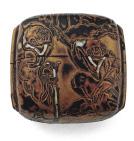
AND DARUMA
Unsigned Japan, 17th century, Edo period (1615-1868)

The large, bulky inro bearing a roiro ground, finely lacquered to both sides in rubbed gold and red hiramaki-e with highlights of kirigane, raden (shell inlays), and nashiji, to depict a seated Hotei raising a tama (flaming pearl) high and sitting before an iridescent flame issuing from a censer. The reverse similarly decorated with Daruma (Bodhidharma) holding a hossu (Buddhist fly whisk) symbolizing the sweeping away of mental distractions and ignorance. The interior compartments lacquered in gold. With a finely carved bone ojime.
HEIGHT 7.6 cm, LENGTH 7.2 cm
Condition: Very good condition with minor typical rubbing to lacquer and expected losses to shell and kirigane inlays.
Provenance: Galerie Souquet, Paris, October 17, 1966. Collection of Robert and Isabelle de Strycker, acquired from the above.
LITERATURE COMPARISON
For a related example depicting Chinese figures sitting by a waterfall see Sydney L. Moss Ltd. (2014) Lac Lacquer Lacquest, pp. 54-55.
Estimate EUR 4,000
Starting price EUR 2,000
1
A RARE SINGLE-CASE LACQUER INRO WITH TEMPLE SERVANTS AND CHARIOT
Unsigned Japan, 17th century, Edo period (1615-1868)
The large, wide-bodied single-case inro bearing a beautifully polished, chestnut-red ground, with some black mottling, lacquered in hiramaki-e and large sectional inlays of raden (shell), depicting two temple servants sitting across from each other, each wearing an eboshi and dressed in courtly attire, the verso similarly decorated with a large chariot. The interior cases of roiro with gold fundame rims.

HEIGHT
Condition: Good, worn condition, with some losses to the lacquered ground, particularly to the top from contact with an ojime.
Provenance: Galerie Pader, Paris, April 1943. Collection of Robert and Isabelle de Strycker, acquired from the above and thence by descent in the same family. The upper case with an old collector’s label, ‘L 565.’
Estimate EUR 2,500
Starting price EUR 1,200
2
6.2 cm, LENGTH 8.5 cm
A SUPERB AND RARE FOUR-CASE LACQUER INRO WITH BUGAKU ACCESSORIES
Unsigned Japan, 17th-18th century, Edo period (1615-1868)

Of rectangular form and oval section, finely layered with twotoned nashiji on a roiro ground and takamaki-e with iridescent aogai (mother-of-pearl) and gold-leaf inlays depicting the various accessories needed to perform the Bugaku dance. A large fan lacquered to one side with dense decorations including a fierce oni mask surrounded by a sinuous dragon. The reverse with two torikabuto and a sho flute. The interior cases of nashiji with gold fundame rims. With a rock crystal ojime.
HEIGHT 7.5 cm LENGTH 6.7 cm
Condition: Very good condition with minor wear, expected losses to the kirigane flakes, and light rubbing to the edges. Presenting beautifully. Provenance: Glendining and Co. Auction, 17 June 1953. Private collection, acquired from the above, assembled by the previous owner’s great-grandfather and thence by descent. The interior with an old collector’s label, ‘678 g. 17/6/53. 1/-/-.’
Bugaku is a Japanese traditional dance. The defining elements of this dance were introduced through Southeast Asia to the Chinese Tang court and its use in Japan dates back to the Heian period (7941185) and is still performed today.
Estimate EUR 5,000
Starting price EUR 2,400
8 3

A RARE FOUR-CASE LACQUER INRO WITH DHARMA WHEELS, HORIN
Unsigned Japan, 17th century, Edo period (1615-1868)
Of upright rectangular form and oval section, bearing a lustrous roiro ground, finely lacquered to both sides in gold takamaki-e with highlights of kirigane and aogai to depict the dharma wheels of Buddhism, horin, the composition spilling over the edge and continuing to the top of the case. Further with manji designs in hiramaki-e, which are partially worn away. The interior compartments of nashiji with gold fundame edges. With a silver lacquer ojime.


HEIGHT 7.2 cm, LENGTH 5.4 cm
Condition: Very good condition with minor wear along the edges, some wear to lacquer, light surface scratches, and some losses to kirigane and aogai. Presenting beautifully.
Provenance: Sotheby’s, 8 June 1950, London. Private collection, acquired from the above, assembled by the previous owner’s great-grandfather and thence by descent. The interior with an old label reading, ‘Buddhism Wheels of the Law in pearl and kirikane, on black ground, Old 17th century piece in excellent condition. S. 8/6/50. ph lot 40. Say C/Bx/-’ and sticker ‘514, S. 8/6/50, C/Bx/-’.
Estimate EUR 3,000
Starting price EUR 1,500
10 4
A RARE FOUR-CASE LACQUER INRO DEPICTING UCHIWA

Unsigned Japan, 17th century, Edo period (1615-1868)
The well-sized inro bearing a roiro ground, finely decorated with gold and red hiramaki-e to depict uchiwa ( on either side. One enclosing stylized shishi and peonies detailed with iridescent raden and aogai, the sides issuing further floral blooms in red lacquer. The reverse similarly decorated within the outline of the fan with scholars in deep discussion next to a pavilion, their robes illuminated by iridescent shell and aogai. The interior compartments of nashiji with gold fundame rims. With a guri lacquer ojime. The accompanying 18th-19th century tsuishu lacquer manju netsuke carved with opulent flowers against a wood ground.
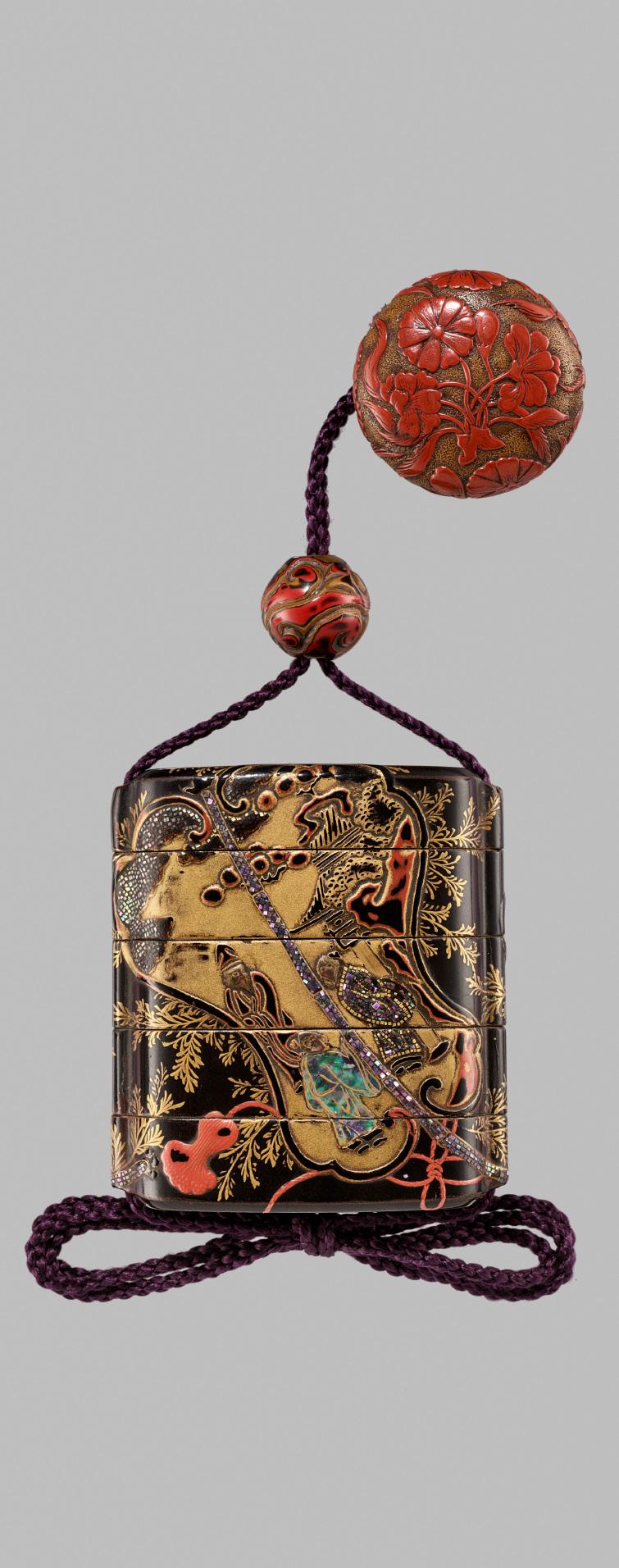
HEIGHT 7.4 cm, LENGTH 6.5 cm
Condition: Very good condition with minor typical wear and few losses to aogai inlays.
Provenance: From the collection of Arend Louis Serné. An old collector’s label to the interior, ‘G 188.’ Arend Louis Serné (19252021) was the fourth-generation owner of the firm A. Serné & Son, Costumiers, located on the Groenburgwal, Amsterdam, Netherlands, established in 1866. An avid piano player, he was also fond of modern literature, and a passionate collector of inro. He started his inro collection in the late 1970s. At that time, he entered the gallery Aalderink Oriental Art along the Spiegelgracht in Amsterdam and was immediately captivated by the beauty of inro. He began his collection with three simple specimens but hoped to own more. He remarked, “Oh that’s nothing, a decent collection must be about a hundred pieces!” And collect he did. Arend was not concerned with the signature or the rarity, but with the intrinsic poetic beauty embodied in this very Japanese art form.
Estimate EUR 3,000
Starting price EUR 1,500
11
5
A FINE SILVER-INLAID FOUR-CASE LACQUER INRO DEPICTING A TIGER AND DRAGON


Unsigned Japan, late 17th century, Edo period (1605-1868)
Of rectangular form and oval section, bearing a fine roiro ground and decorated in takamaki-e and hiramaki-e with small gold and red lacquer kirigane flakes. One side decorated with a powerful dragon, inlaid in silver, surrounded by swirling clouds and gold whisps of wind. The reverse with a tiger, inlaid in shakudo, on a riverbank with rolling waves and bamboo shoots sprouting from the shore. Both frames set within a recessed floral panel. The base and top decorated with light nashiji clouding and the interior cases of dense nashjiji with fundame rims.
HEIGHT 6.7 cm, LENGTH 5.8 cm
Condition: Very good condition with minor wear, light rubbing, and typical losses to the kirigane flakes.
Provenance: Sotheby’s, 8 June 1950, London. Private collection, acquired from the above, assembled by the previous owner’s greatgrandfather and thence by descent. The interior with an old label reading, ‘Silver dragon in clouds: on reverse tiger and bamboo. Old 17th century piece. S 8/6/50 W/BX/-.‘
The dragon and tiger are symbols of the two opposing and yet complimentary forces of yin and yang. The dragon, a mythical animal thought to reign over the heavens, stands for yang. The tiger, respected in ancient China as the mightiest of the wild beasts, stands for yin. They are often paired together in painting compositions but appear substantially less often in suzuribakos. Furthermore, the female tiger here is represented with spotted fur resembling a leopard. As the leopard is not native to Japan, artists had only seen leopard fur on occasion and had deduced it must belong to a female tiger.
MUSEUM COMPARISON
Compare a closely related inro bearing a similar design of tiger and dragon in the Metropolitan Museum of Art (The MET), New York, accession no. 12.134.19

Estimate EUR 2,500
Starting price EUR 1,200
12 6
AN
INLAID FOUR-CASE LACQUER INRO DEPICTING KYOYU AND SOFU
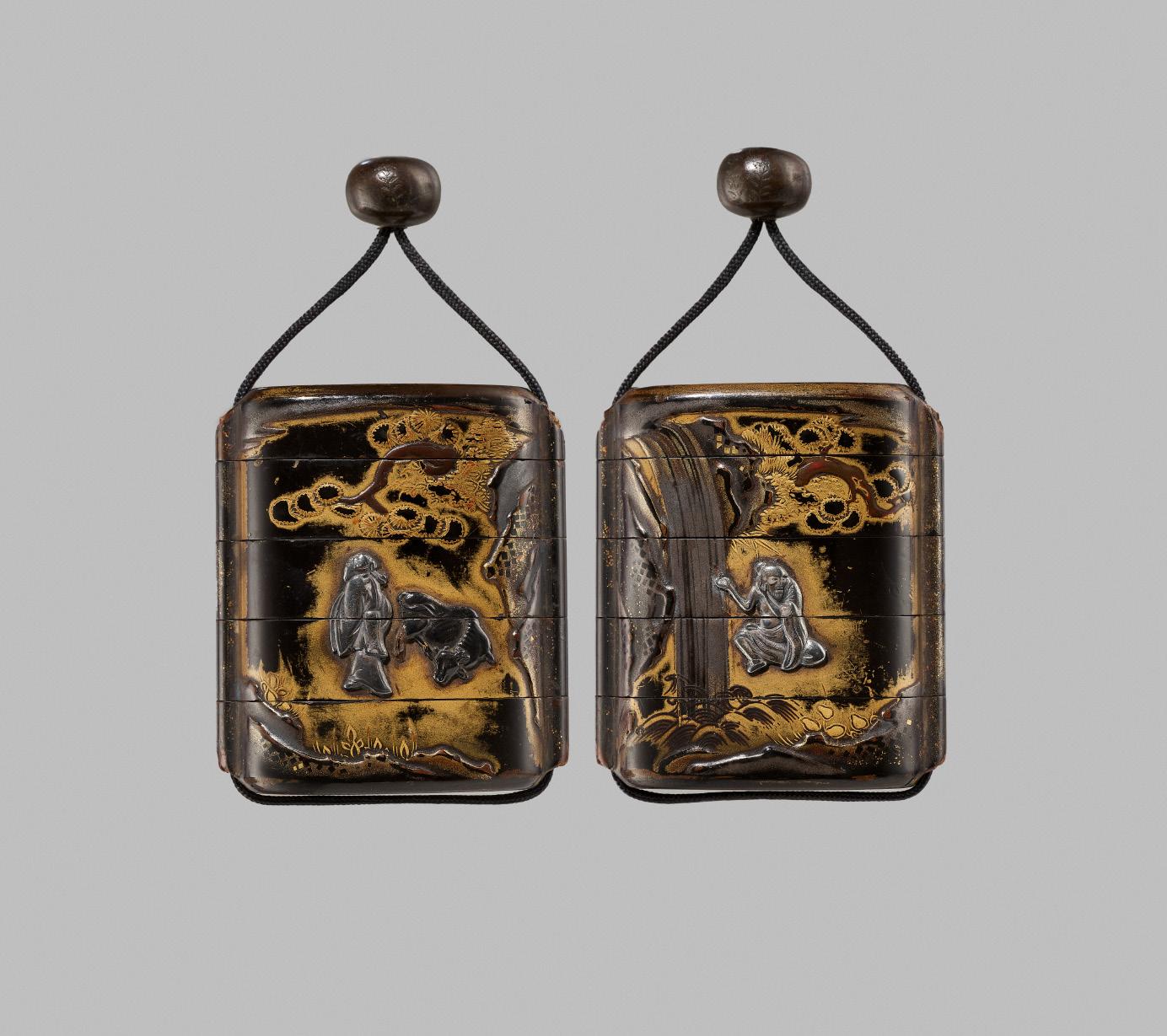
Unsigned Japan, 17th century, Edo period (1615-1868)
Of rectangular form and oval section, finely lacquered in gold and silver with details in hiramaki-e and with kirigane flakes. Inlaid in silvered metal, Kyoyu is depicted kneeling at the dark waterfall and washing his ears while looking back over his shoulder towards Sofu; the hermit surrounded by rockwork with foliage and an overhanging pine branch. On the reverse, Sofu, surrounded by similar fauna, stands next to his recumbent ox looking towards Kyoyu in realization he can no longer wash his ox in the waterfall. The base and top with gold fundame. The interior cases of nashiji with gold fundame edges. With a florally incised metal ojime.
HEIGHT 6.1 cm, LENGTH 5.2 cm
Condition: Good condition with wear, signs of use, light rubbing, and minor chips to the corners of the cord runners.
Provenance: Galerie Pader, April 1943, Paris. Norton Gallery, 7 April 1959, Paris. Collection of Robert and Isabelle de Strycker, acquired from the above and thence by descent in the same family. The upper case with an old collector’s label, ‘L 574.’
Gyo was among of the most highly esteemed of the ancient Chinese emperors. He abdicated the throne upon hearing the plight of the poor hermit named Xu You (Jap. Kyoyu). Upon abdicating the throne, Gyo offered his throne to the hermit, but after hearing the emperor’s offer, Xu You immediately traveled to Eisen River to wash his ears free of the temptation the emperor had filled them with. As he was washing out his ears the hermit Chao Fu (Jap. Sofu) met him, leading an ox he intended to bathe in the same waterfall. However, after speaking with Xu You, he realized he could not bathe the animal in such dirty waters, calmly moving on in search of cleaner water.
This story is often recounted as an illustration of the Daoist ideal of nothingness, but it was also popular among members of the military class as an anecdote with a wry, cynical attitude toward worldly success or failure; this same story subsequently was made a frequent theme of paintings done in the Chinese style.
Estimate EUR 1,500
Starting price EUR 800
7
A GOLD LACQUER FOUR-CASE INRO DEPICTING A KIRIN AND HO-O BIRD


Unsigned Japan, 17th-18th century, Edo period (1615-1868)
Of upright rectangular form and oval section, the four-case inro lacquered in gold and iro-e takamaki-e against a gold fundame ground, depicting a galloping kirin with its head turned slightly, with flames emanating from its body. The reverse depicting a descending ho-o bird, its plumage rendered in shades of gold and brown with kirigane highlights. The interior lacquered in nashiji with gold fundame rims.
With a patterned glass ojime in stripes of blue, white, and red. The accompanying red-lacquered pressed horn manju netsuke depicting Kato Kiyomasa slaying the tiger.
HEIGHT 6 cm, LENGTH 4.9 cm
Condition: Good condition with minor wear to lacquered ground, with streaks of black lacquer coming through. Some tiny, typical losses along the edges of the risers. A small age crack to the side of the third case.
Estimate EUR 1,500
Starting price EUR 800
9 CHIKANAO: A FINE LACQUERED THREE-CASE INRO OF A HO-O BIRD AND KIRI
By Ueda Chikanao, signed Chikanao 近直 zu圖 Japan, 18th century, Edo period (1615-1868)
Of upright rectangular form, bearing a black-lacquered ground, finely decorated in gold hiramaki-e with highlights of silver and red lacquer to depict a ho-o bird perched on a paulownia (kiri) tree to one side, the other with another ho-o bird flying near peony blossoms issuing from craggy rocks, all within a foliate reserve. The feathers neatly detailed and colored to highlight the plumage of the bird which is further highlighted by kirigane. The rocks, tree trunk, and stems similarly decorated. The clever inclusion of red lacquer in the fruit and flowers further exemplifying the composition. The interior compartments of nashiji with gold fundame edges. Signed underneath in red lacquer CHIKANAO zu [painted by Chikanao]. With a faceted bone ojime.
HEIGHT 6.2 cm, LENGTH 5.3 cm
Condition: Good condition and presenting well. Tiny losses to edges, some losses to lacquer and kirigane, light surfaces scratches, all as expected with this type of early inro.
Ueda Chikanao is mentioned in the Soken Kisho of 1781.
Estimate EUR 1,500
Starting price EUR 800
14 8
A RARE TWO-CASE LACQUER INRO DEPICTING AN IDYLLIC LANSCAPE
Unsigned Japan, 17th-18h century, Edo period (1615-1868)
The small two-case inro bearing a fine roiro ground, each side featuring a quatrefoil lobed reserve framed by raden (shell) inlay, one side depicting an idyllic scene of two pavilions surrounded by large craggy rocks, prunus, and a towering willow. The other side with further prunus, hills, and ferns. The lacquer techniques are mostly gold hiramaki-e with some kirigane. The exterior of the reserves lacquered with a hiramaki-e hanabishi design. The interior cases of roiro with gold fundame rims.
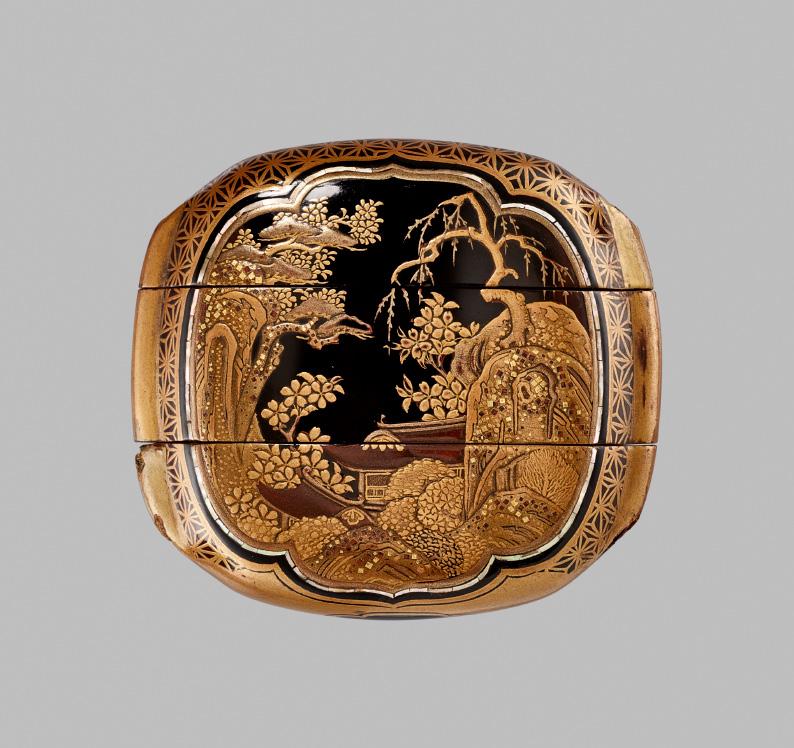
HEIGHT 5.8 cm, LENGTH 6.5 cm
Condition: Good condition with minor wear and minuscule losses to the shell inlay. The cord runners with minor chips, two of them with repairs in gold lacquer.
Estimate EUR 1,500
Starting price EUR 800
AN EARLY THREE-CASE LACQUER INRO WITH TEA CEREMONY UTENSILS (CHADOGU)
Unsigned Japan, late 17th to early 18th century, Edo period (1605-1868)
The early, small three-case inro of rectangular and oval form, bearing a roiro ground, decorated in takamaki-e with hiramaki-e details, depicting a large natsume (tea caddy) decorated with gold kiku (chrysanthemum) blossoms, sitting on a brocade cloth with various geometric designs and kiku medallions. The reverse with a gold-splashed chawan (tea bowl) resting on the cloth. The top and sides embellished with further kiku motifs. The interior cases of nashiji with gold fundame rims.

HEIGHT 5.6 cm, LENGTH 5.2 cm
Condition: Good condition with typical wear along the edges, tiny losses, and some surface scratches.
Provenance: Hotel des ventes Giroux, 4 October 1947, Brussels. Galerie Duval, 2 February 1949, Brussels. Collection of Robert and Isabelle de Strycker, acquired from the above and thence by descent in the same family. The upper case with an old collector’s label, ‘L 574.’
Estimate EUR 1,500
Starting price EUR 800
15 10
11
A FINE FOUR-CASE INRO DEPICTING BIRDS IN FLIGHT ABOVE NETS AND FISH TRAPS
Unsigned Japan, late 17th to early 18th century, Edo period (1615-1868)
Of rectangular and flattened form, finely lacquered in hiramaki-e on a roiro ground which is polished in sections to reveal the red lacquer base giving the piece a superbly rustic appearance. The front decorated with birds flying near a drying net, both inlaid with iridescent mother of pearl. The reverse with a fisher’s trap made of mother-of-pearl on the shore next to swirling water. The layers of lacquer are highlighted by gold hiramaki-e, most visible in the design of the water. The edges with karakusa designs in hiramaki-e. The interior cases of roiro with gold fundame edges. With a reticulated antler ojime.
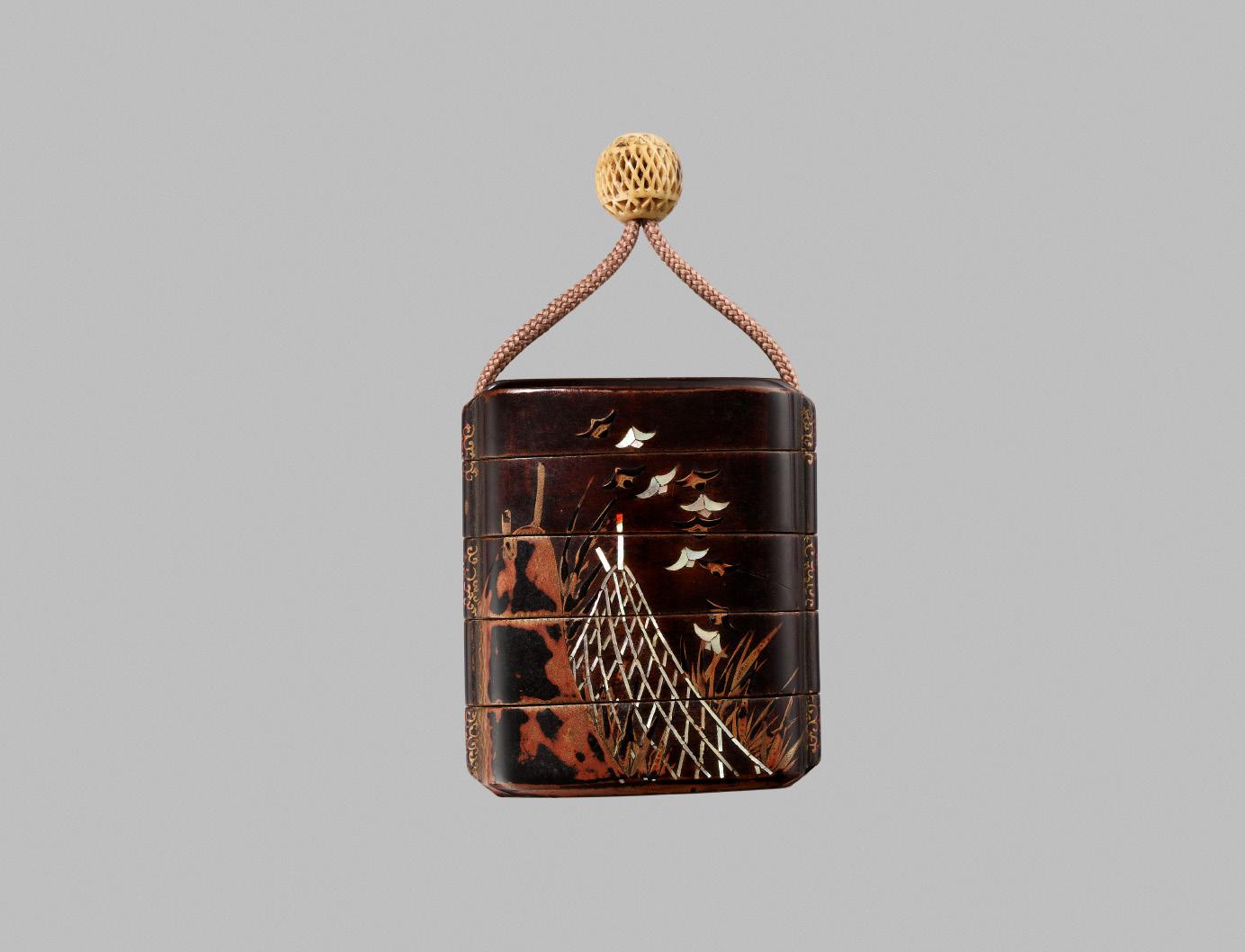
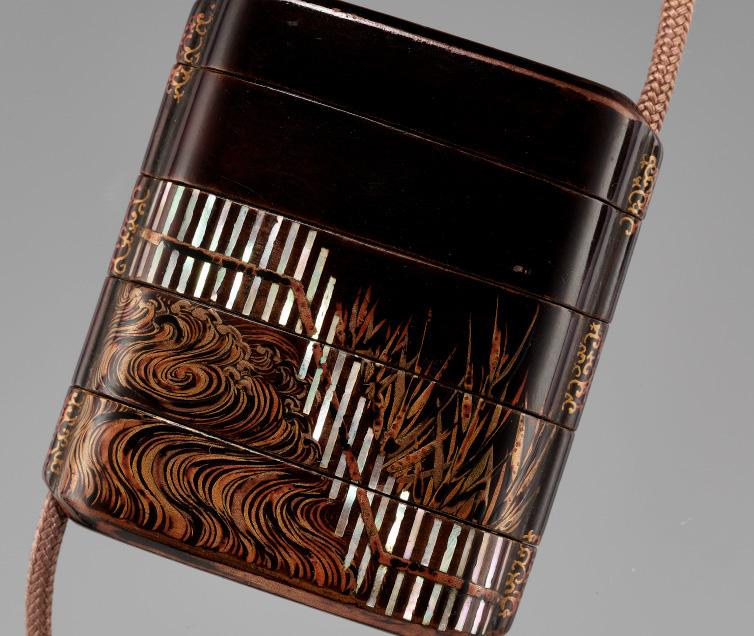
HEIGHT 5.8 cm, LENGTH 5 cm
Condition: Very good condition with minor wear, minuscule losses to the mother-of-pearl, light rubbing to the edges, and a small nick to one corner of the cord runner.
Provenance: From a private collection in Switzerland. The interior with an old collector’s number, ‘108.’
Gulls and other seabirds typically follow fishing boats in order to pick up scraps left in their wake. This lot depicts a moment of stillness, when the fishermen have left and the birds are free to pick the scraps from the nets of the fishermen.
MUSEUM COMPARISON
Compare a related inro with the same shape and with a similar motif of a heron next to a fish trap, unsigned, dated between the 17th and 18th century, in the Musée National des Arts AsiatiquesGuimet, accession number 16073.0016.

Estimate EUR 3,000
Starting price EUR 1,500
16
12
13
A RARE AND AMUSING THREE-CASE LACQUER INRO DEPICTING A PERFORMING TROUPE

Attributed to Tsuchida Soetsu (c. 1660-1745), unsigned Japan, late 17th to early 18th century, Edo period (16151868)

The early small three-case inro of rectangular from, bearing a roiro ground, decorated in gold takamaki-e and hiramaki-e with some typical inlays of mitsuda (pewter) and mother-of-pearl. The charming motif depicting a troupe of performers with three figures on one side pulling desperately at an inlaid rope attached to a stuck pole on which a stubborn monkey sits, wearing an inlaid motherof-pearl hat, as a crowd of five figures gesticulate and laugh as they watch. The top and bottom as well as the sides decorated with gold-lacquered geometric designs. The interior cases of nashiji with gold fundame edges. With a reticulated bone ojime.
HEIGHT 5.3 cm, LENGTH 6.1 cm
Condition: Good condition with wear, losses to some inlays and ojime, tiny nicks, some losses to the interior gold fundame lining, all consistent with age and use and overall presenting well.
Provenance: Gallery Van Stockum, the Hague, 25 June 1957. Collection of Robert and Isabelle de Strycker, acquired from the above and thence by descent in the same family. The upper case with an old collector’s label, ‘L 565.’
The first Tsuchida Soetsu may have lived between 1660-1745, possibly a descendant of one of the Tsuchida artists living and working at Koetsu’s Takagamine enclave near Kyoto. His inro are said to have been large, but most examples of his work still in existence are rather small in size. The first Soetsu later changed his name to Shoetsu, handing on the name of Soetsu to his successors in the lineage.
The design was likely copied or inspired by the work of Hanabusa Itcho (16521724), the comical faces and subject matter being very much in line with Itcho’s work.
AUCTION COMPARISON
Compare a related threecase lacquer inro depicting a carp and fishnet, signed Shoetsu, with similarly applied mother-of-pearl inlays, at Bonhams, The Edward Wrangham Collection of Japanese Art Part IV, 6 November 2013, London, lot 140 (sold for GBP 5,250).
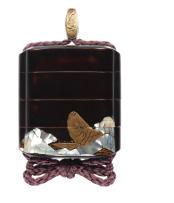
Estimate EUR 3,000
Starting price EUR 1,500
17
Hanabusa Itcho (16521724), performers travelling in a boat. Bonhams, Fine Japanese Art, 10 November 2011, London, lot 256
A CHARMING SMALL FOUR-CASE GOLD LACQUER INRO WITH THE MOON RABBIT


Unsigned Japan, 17th century, Edo period (1615-1868)
The five-case inro lacquered in takamaki-e against a gold kinji ground, depicting the silhouette of a rabbit’s head next to three young fern shoots (warabi) inlaid in mother-of-pearl. The reverse with a large moon in pewter (mitsuda). The interior compartments of black lacquer with gold fundame edges.
HEIGHT 5.7 cm, LENGTH 4.8 cm
Condition: Worn condition with some rubbing to lacquer, few losses, particularly to the pewter-inlaid moon, and some crackling throughout.
Provenance: Marché Biron, Paris, April 1943. Collection of Robert and Isabelle de Strycker, acquired from the above, and thence by descent within the same family. An old collector’s label to the interior, ‘L,542.’
Estimate EUR 1,500
Starting price EUR 800
18 14
YOSEI: A FINE TSUISHU AND MITSUDA INLAID THREE-CASE LACQUER INRO WITH BUFFALO AND DRAGONFLIES
 By Tsuishu Yosei, signed Yosei 楊成 zo 造 Japan, 17th-18th century, Edo period (1615-1868)
By Tsuishu Yosei, signed Yosei 楊成 zo 造 Japan, 17th-18th century, Edo period (1615-1868)
Of upright rectangular form and oval section, bearing a lustrous roiro ground, lacquered in tsuishu (carved red lacquer) with frolicking dragonflies above grasses and leaves incised and filled with gold lacquer. The reverse similarly decorated and with a stumpy ox inlaid in mitsuda (pewter), sitting with his back facing the viewer, as he rests on the ground. The interior compartments of roiro with gold fundame edges. Incised to the bottom YOSEI zo [made by Yosei].

HEIGHT 6.9 cm, LENGTH 5.3 cm
Condition: Very good condition with minor wear and few light surface scratches.
Provenance: From an old French private collection. Three old collector’s labels to the first case, ’58,’ ’58,’ and ‘Yosei, E/EG/B.’
The Yosei family can be traced back to as early as the 14th century, however, the school was formally founded in the first half of the 17th century by Tsuishu Yosei VIII. He was succeeded by another twelve generations. The school mainly focused on the tsuishu technique, but also worked in tsuikoku, guri, and chinkinbori. A great variety of artifacts were produced including inro, netsuke, and ojime.
MUSEUM COMPARISON
A closely related lacquered inro with tsuishu dragonflies over flowers by Yosei is in the Toledo Museum of Art, Ohio, object no. 1950.75C.


AUCTION COMPARISON
Compare a related lacquered inro of five formal characters by Yosei at Bonhams, Fine Japanese Art, 16 May 2013, lot 144 (sold for GBP 25,000).
Estimate EUR 2,000
Starting price EUR 1,000
19
15
16
SOSHU: A FINE TSUISHU AND SHIBAYAMA INLAID SINGLE-CASE INRO DEPICTING A CRANE AND PEACH
By Soshu (Munemori), signed Soshu 宗守 Japan, Tokyo, Meiji period (1868-1912)
The wide-bodied two-case inro bearing a finely polished, lustrous roiro ground, inlaid to the front in tsuishu (carved red lacquer) with a crane depicted mid-flight, the verso depicting a fruiting peach branch inlaid in the Shibayama-style with mother-of-pearl, hardstone, wood, and pewter, next to gold hiramaki-e swirls. Both the crane and peach are auspicious symbols of longevity. Signed to the underside within an inlaid seal signature tablet SOSHU (Munemori) – likely a pupil of Shibayama Soichi (Munekazu). With an agate ojime.


HEIGHT 7.5 cm, LENGTH 5.5 cm
Condition: Very good condition with minor wear along the edges of the risers and some minor general wear throughout. Few tiny cracks.
Provenance: From the collection of Donald Snow, Boston, Massachusetts, USA.
Estimate EUR 3,000
Starting price EUR 1,500
20
A FINE MOTHER OF PEARL AND HARDSTONE INLAID FOUR-CASE LACQUER INRO WITH FRUITING PEACHES

Unsigned Japan, late 19th century, Meiji period (1868-1912)
Of upright rectangular form and oval section, bearing a lustrous roiro ground, finely decorated in gold takamaki-e with kirigane and inlays of mother-of-pearl and hardstone, to depict a verdant peach branch with blossoming flowers and buds, and some ripe fruits, all borne on leafy stems. The interior compartments of red lacquer with gold fundame edges.

HEIGHT 8.3 cm, LENGTH 5.3 cm
Condition: Good condition with minor wear, few light scratches, some tiny losses along the edges and some minor rubbing and losses to lacquer.
Provenance: From the collection of Arend Louis Serné. An old Japanese label to the interior of the top case. Arend Louis Serné (1925-2021) was the fourth-generation owner of the firm A. Serné & Son, Costumiers, located on the Groenburgwal, Amsterdam, Netherlands, established in 1866. An avid piano player, he was also fond of modern literature, and a passionate collector of inro. He started his inro collection in the late 1970s. At that time, he entered the gallery Aalderink Oriental Art along the Spiegelgracht in Amsterdam and was immediately captivated by the beauty of inro. He began his collection with three simple specimens but hoped to own more. He remarked, “Oh that’s nothing, a decent collection must be about a hundred pieces!” And collect he did. Arend was not concerned with the signature or the rarity, but with the intrinsic poetic beauty embodied in this very Japanese art form.
Estimate EUR 3,000
Starting price EUR 1,500
21 17
A FINE KOAMI-SCHOOL LACQUERED SINGLE-CASE INRO WITH DRAGONFLIES
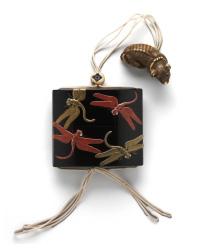
Unsigned Japan, 19th century, Edo period (1615-1868)
The wide-bodied, single-case inro of horizontal rectangular form and oval section, bearing a superbly polished, lustrous roiro ground, finely lacquered in thick red and gold takamaki-e with five dragonflies, the thick lacquer pooling attractively and spilling over the edges. The eyes inlaid with iridescent mother-of-pearl, the wings and legs detailed with gold hiramaki-e. The interior cases of red lacquer with gold fundame rims.

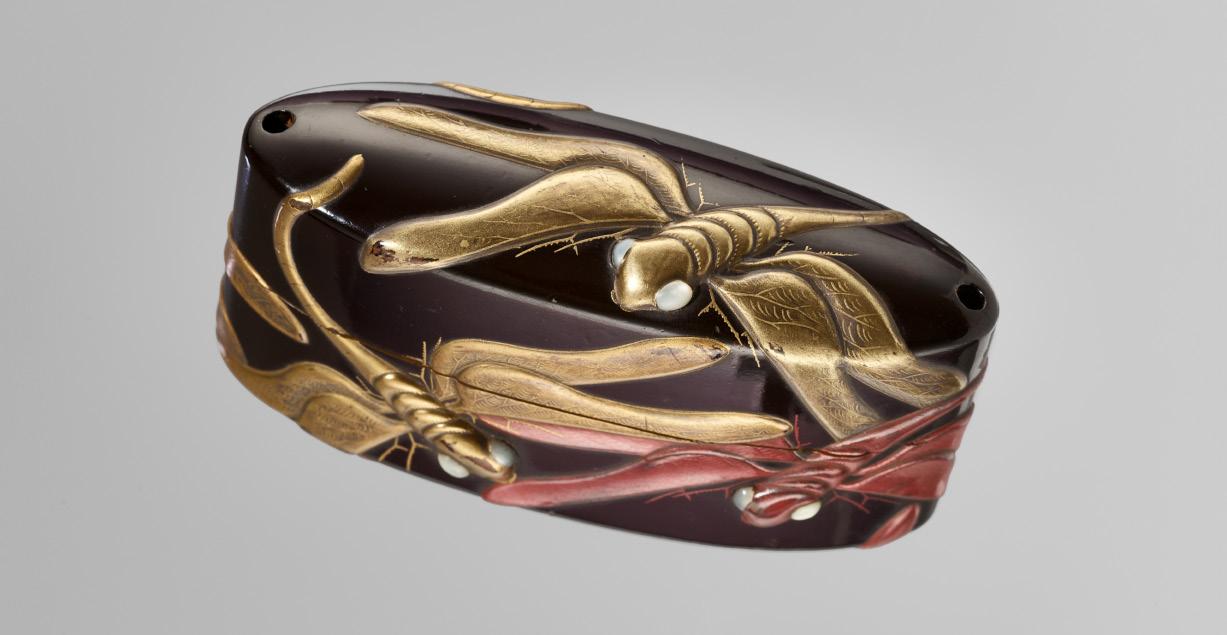
HEIGHT 5.1, LENGTH 9.3 cm
Condition: Very good condition with minor wear to lacquer along the edges and some minor rubbing to the high points. Tiny chip to the edge of one of the cord holes.
Provenance: Glendining & Co Auction, 15 December 1947. A noted private collection, assembled by the previous owner’s greatgrandfather and thence by descent. With an old collection label to the interior of the top case.
The Koami family is one of the most famous dynasty of lacquerers, founded according to tradition by Docho. The family worked extensively for the court and the shogunate until well into the 19th century and had a considerable influence on the development of lacquer art through its leadership of the teams of craftsmen that worked on important shrines and palaces and other national projects. The family is also credited with having created the technique and style known as kodaijimaki-e. The shapes, subjects, and techniques of Koami inro are so varied that no family style can be identified.
MUSEUM COMPARISON
A closely related lacquered inro with dragonflies by Koami Nagataka is in the Metropolitan Museum of Art (The MET), New York, accession no. 13.67.23.
Estimate EUR 5,000
Starting price EUR 2,400
18

TOYOSAI: A SUPERB TWO-CASE LACQUER INRO DEPICTING ISE-EBE AND SALMON
By Kanshosai Toyosai, signed Toyosai 桃葉斎 with seal Kanshosai 観 松斎
Japan, Edo (Tokyo), late 18th to early 19th century, Edo period (1615-1868)
Of horizontal rectangular form and oval section, bearing a lustrous roiro ground, one side lacquered in thick red takamaki-e to depict an ise-ebi (spiny lobster) in front of a hiramaki-e ferns in gold, the other side with a gold and silver takamaki-e salmon attached to a cord, the fish partly scaled to reveal the lustrous reddish-silver insides. The interior compartments of nashiji with gold fundame edges. Signed to the bottom TOYOSAI in gold lacquer with a redlacquered seal Kanshosai.
HEIGHT 5.6 cm, LENGTH 7.4 cm
Condition: A fine crack to the top case. Some light surface scratches. Generally in very good condition with minor typical wear to edges and presenting well.
Provenance: Old French private collection. Three old collector’s labels affixed to the exterior and interior of the top case, including an old Japanese label and two further collector’s labels ’55,’.
Kanshosai Toyosai was a distinguished lacquerer and inro decorator who worked during the second half of the 18th century in Edo.
AUCTION COMPARISON
Compare a related five-case lacquer inro by the Kajikawa family depicting nine ise-ebi at Bonhams, The Harriet Szechenyi Sale of Japanese Art, 8 November 2011, London, lot 297 (sold for GBP 21,250).



Estimate EUR 6,000
Starting price EUR 3,000
24 19

20
HARA YOYUSAI: A SUPERB AND VERY RARE FIVE-CASE GOLD LACQUER INRO WITH DUTCHMEN
By Hara Yoyusai (1772-1845/6), signed Yoyusai saku 羊遊斎作 Japan, first half of 19th century, Edo period (1615-1868)
Published: Oriental Art Magazine (1957), vol. 3, no. 1, p. 15.
Of upright form and oval section, bearing a beautiful and lustrous gold kinji ground, lacquered in iro-e takamaki-e with some hiramaki-e details, depicting to the front a Dutchman dressed in traditional robes and holding a cane and long kiseru (pipe), looking to his left at a hound being presented to him by his fellow countryman. The verso depicts a Dutch ship arriving at Nagasaki harbor, amid turbulent waves and silver-lacquered sprays, a few Dutchmen visible on the ship below the majestically towering masts and sails. Signed to the underside YOYUSAI. The interior cases of nashiji with gold fundame rims.




With a fine gold ojime depicting a cricket amongst grasses.
HEIGHT 11.3 cm, LENGTH 5.5 cm
Condition: Excellent condition with only very minor wear.
Provenance: Sotheby’s, 17 December 1957, London. A noted private collection, assembled by the previous owner’s greatgrandfather and thence by descent. With old collection labels to the interior of the top case.
The design of the present inro were likely taken from Nagasaki prints, Nagasaki-e, a genre of ukiyo-e woodblock prints, produced in Nagasaki during the Edo period, that depict the port city of Nagasaki, the Dutch and Chinese who frequented it, and other foreign curiosities such as exotic fauna and Dutch and Chinese ships.
Hara Yoyusai (1772-1845/6) lived in Edo and worked under the patronage of Lord Matsudaira.
AUCTION COMPARISON
Compare a related silver lacquer five-case inro by the same artist and signed Yoyusai saku, depicting Portuguese traders at Bonhams, 6 November 2012, London, lot 37 (sold for GBP 46,850). Also compare a related gold lacquer five-case inro, depicting Dutchman, by the Kajikawa family, at Zacke, Fine Netsuke & Sagemono, 28 April 2023, Vienna, lot 343 (sold for EUR 10,400).

Estimate EUR 15,000
Starting price EUR 8,000
26
Nagasaki print of a Dutchman depicted in a similar style as the present inro

21
Unsigned Japan, c. 1800, Edo period (1615-1868)
The two-case inro bearing a superb tsuishu (carved red lacquer) frame with alternating asanoha and manji designs, with a circular panel to either side, one featuring a view of a Dutch ship entering Nagasaki bay, decorated in gold and silver hiramaki and takamaki-e, with some nashiji. The panel on the verso bearing a nashiji ground and decorated in gold and colored takamaki-e with a zodiac (junishi) compass, the central roundel decorated with gold karakusa and the needle pointing at the rat (nezumi). Most likely this inro was commissioned by a Dutch settler born in the year of the rat.


With a matching gold-lacquered ojime and wood and lacquer kagamibuta netsuke decorated with European enameling and depicting scenes with foreigners. The netsuke with the initials ‘A.J.’ to the top and the wood bowl lacquered with a blossoming and budding flower.
HEIGHT 6.3 cm, LENGTH 7.3 cm DIAMETER (the netsuke) 3.7 cm
Condition: Very good condition with only very minor wear.
Provenance: Sotheby’s, 17 December 1951, London. A noted private collection, acquired from the above, assembled by the previous owner’s great-grandfather and thence by descent. With old collection labels to the top case.
Estimate EUR 8,000
Starting price EUR 4,000
28
A Dutch ship entering Nagasaki bay, from Oranda fune (The Dutch Ship), from Nihon sankai meisan zue (Famous Products of Japan’s Mountains and Seas, Illustrated), 1799
A VERY RARE TSUISHU AND LACQUER TWO-CASE INRO, MOST LIKELY COMMISSION BY A DUTCH SETTLER
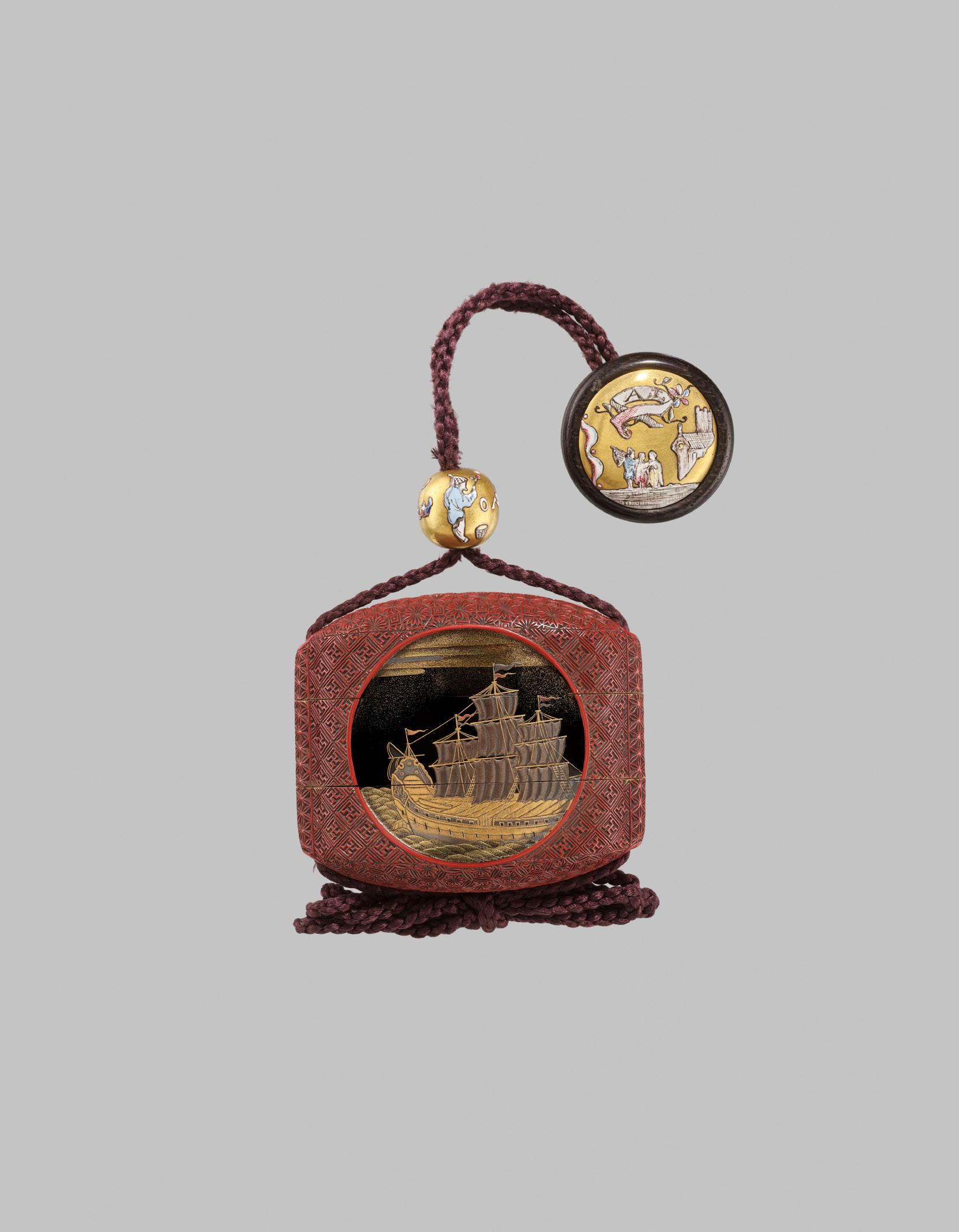
A TSUISHU LACQUER FOUR-CASE INRO DEPICTING KYOYU AND SOFU, WITH EN SUITE NETSUKE AND OJIME


Unsigned
Japan, 18th-19th century, Edo period (1615-1868)
Of tall rectangular form with a lenticular profile, finely carved in relief with Kyoyu washing his ears in the waterfall surrounded by impressive rockwork with pine branches and bamboo, and further with finely incised manji and asanoha. The reverse with Sofu, holding his ox by one horn, standing beneath a tall pine with similarly decorated grounds. Each frame is set within the recess of a geometric frame surrounded by etched brocade patterns. The upper case decorated with a central pine branch within the recess of a similar frame, and the base with a manji diaper.
The en suite tsuishu netsuke in the form of a star-shaped Chinese low table, with the upper recess decorated with a literati looking up at the moon with his attendant beneath a gnarled pine tree. Further with a mixed metal ojime decorated with kiku (chrysanthemum) blossoms beneath a cloudy moonlit sky bearing the artist’s signature in an oval reserve Kagenori.
HEIGHT 9.4 cm, LENGTH 3.7 cm
Condition: Very good condition with minor wear and traces of use to the interior. The ojime and netsuke similarly in very good condition with only minor typical wear.
Provenance: Ex-collection of Donald Snow, United States. The interior with an old Japanese label.
Gyo was among of the most highly esteemed of the ancient Chinese emperors. He abdicated the throne upon hearing the plight of the poor hermit named Xu You (Jap. Kyoyu). Upon abdicating the throne, Gyo offered his throne to the hermit, but after hearing the emperor’s offer, Xu You immediately traveled to Eisen River to wash his ears free of the temptation the emperor had filled them with. As he was washing out his ears the hermit Chao Fu (Jap. Sofu) met him, leading an ox he intended to bathe in the same waterfall. However, after speaking with Xu You he realized he could not bathe the animal in such dirty waters, calmly moving on in search of cleaner water.
This story is often recounted as an illustration of the Daoist ideal of nothingness, but it was also popular among members of the military class as an anecdote with a wry, cynical attitude toward worldly success or failure; this same story subsequently was made a frequent theme of paintings done in the Chinese style.
Estimate EUR 2,000
Starting price EUR 1,000
30 22
A FINE TSUISHU THREE-CASE LACQUER INRO WITH KARAKO AT PLAY, WITH EN SUITE NETSUKE AND OJIME

Unsigned Japan, 18th-19th century, Edo period (1615-1868)
The three-case inro of upright form and oval section, lacquered in tsuishu (carved red lacquer) and finely worked in high relief within panels depicting playing karako boys. In one room, obscured partially by a thick curtain, one boy plays with his ‘fish-on-wheels’ as another teases an infant with a rattle. The room detailed with screens and thatched floors, with a window to the outside. The reverse similarly depicting playing karako, one peering over a screen detailed with karakusa, all below pine trees against a wave ground. The sides incised with swirls. The interior cases lacquered in black.
With a beautifully matching tsuishu ojime decorated with foliate scrolls and a fine tsuishu kagamibuta netsuke with a bat amongst blooming peony, the top carved with a scholar reserved within a rinzu band, the underside with a central himotoshi and a finely incised asanoha ground.

HEIGHT 7.4 cm, LENGTH 6 cm
Condition: Very good condition with minor wear and rubbing, the lid of the kagamibuta with some losses.
Estimate EUR 2,000
Starting price EUR 1,000
31 23
ZOKOKU: AN UNUSUAL TWO-CASE TSUISHU LACQUER INRO WITH PEONY, LILIES, AND REISHI
 By Tamakaji Zokoku
By Tamakaji Zokoku
Of unusual form and oval section, containing one large and one smaller case for medicine, finely carved in low relief with a large peony blossom extending from the right side, borne on a leafy stem against a neatly incised wave ground. The reverse carved with a spray of lilies with one reishi rising from behind. Each frame is set with a quadrilobed border and flanked above and below by a rinzu band. The top and bottom are finely decorated with a large floral medallion surrounded by curling leaves, the bottom bearing the seal signature of the artist, ZOKOKU, within the center of the medallion. With a faux coral ojime.

HEIGHT 10 cm, LENGTH 5.8 cm
Condition: Very good condition with only minor wear and traces of use.
Provenance: Collection of Robert and Isabelle de Strycker, acquired from the above and thence by descent in the same family. The upper case with an old collector’s label, ‘L 619.’
The production of lacquerware in Kagawa (Shikoku) was encouraged by daimyo Yorishige Matsudaira (1622-1695) and many artisans took up residence the area. Zokoku Tamakaji was born in Takamatsu in 1806, but at the age of 20 he moved to Kyoto to study with various painters and lacquerers and had the opportunity to research Chinese lacquer techniques, then bringing his knowledge to Kagawa and helping to seal its reputation as a major lacquerware producing area.
Estimate EUR 6,000
Starting price EUR 3,000

32
24
(1806-1869), signed Zokoku象谷 Japan, Kagawa, c. 1850, Edo period (1615-1868)
Isabelle and Robert de Strycker, c. 1930-1935

A FINE TSUISHU THREE-CASE LACQUER INRO DEPICTING CONFUCIUS MEETING WITH LAO TZU
Unsigned Japan, 18th-19th century, Edo period (1615-1868)
The three-case inro of rounded upright form and oval section, lacquered in tsuishu (carved red lacquer) and finely worked in high relief depicting Confucius’s meeting with Lao Tzu. Confucius depicted receiving a set of scrolls from Lao Tzu, who has retired to a life of asceticism, as he sits on a craggy rock under a pine tree. The landscape with high peaks detailed in black lacquer, all beneath finely carved pine trees. The verso carved with a departing Confucius seated within a carriage drawn by horses and surrounded by his students curious to know what their master has learnt. The details carefully carved in relief and the sides incised with guri lacquer swirls. The interior compartments lacquered in black.


HEIGHT 8.7 cm, LENGTH 5.6 cm
Condition: Very good condition with minor wear and tiny losses along the edges.
Provenance: Norton Gallery, London, 13 November 1957. Collection of Robert and Isabelle de Strycker, acquired from the above, and thence by descent within the same family. An old collector’s label, ‘N 289 bis.’
Estimate EUR 3,000
Starting price EUR 1,500
34 25
KAJIKAWA: AN UNUSUAL TWO-CASE LACQUER INRO WITH VARIOUS LACQUER TECHNIQUES
By a member of the Kajikawa family, signed Kajikawa 梶川 saku 作 with seal Ei 榮 Japan, 18th-19th century, Edo period (1615-1868)
The small two-case inro of oval shape, bearing a lustrous gold kinji ground and decorated in takamaki-e with five roundels worked in various lacquer techniques such as guri, tsuishu, and tsuikoku, depicting old Chinese motifs. The gold kinji ground bearing a further design of scrolling lotus in red and gold hiramaki-e. Signed underneath KAJIKAWA saku [made by Kajikawa] with red tsubo (pot) seal Ei. The interior cases of nashiji with gold fundame rims. With a small bone ojime.

HEIGHT 6 cm, LENGTH 4 cm
Condition: Very good condition with minor, typical wear. Few tiny losses to the edges of the roundels and a microscopic dent from contact with an ojime to the top case.
Provenance: Gallery Van Stockum, The Hague, 21 May 1958. Collection of Robert and Isabelle de Strycker, and thence by descent within the same family.

Estimate EUR 3,000
Starting price EUR 1,500
35
26
Isabelle and Robert de Strycker, c. 1930-1935
KAN: A SUPERB CERAMIC-INLAID THREE-CASE LACQUER INRO DEPICTING A PARROT, WITH HAIKU POEM BY MATSUO BASHO
By Ogawa Haritsu
The three-case inro of square shape and bearing a superbly polished roiro ground, lacquered in red and gold takamaki-e, with creamy-white ceramic inlay, depicting a parrot lowering its head towards a bird feeder. The verso fittingly inscribed with a famous poem by the haiku poet Matsuo Basho (1644-1694): mono ieba, kuchibiru samushi, aki no kaze [When you say something, your lips will feel the chill of an autumn wind]. It is a caution against idle talk. The two sides of the inro thus combining very well, as parrots (and some people) tend to repeat everything they hear. The interior cases lacquered in red with fundame rims. With two further characters inscribed Basho 芭蕉 and sealed Kan [for Ogawa Haritsu, Ritsuo].
HEIGHT 7 cm, LENGTH 7 cm
Condition: Very good condition with minor wear to lacquer and very light rubbing to the ground.
Provenance: From the collection of Arend Louis Serné. Arend Louis Serné (1925-2021) was the fourth-generation owner of the firm A. Serné & Son, Costumiers, located on the Groenburgwal, Amsterdam, Netherlands, established in 1866. An avid piano player, he was also fond of modern literature, and a passionate collector of inro. He started his inro collection in the late 1970s. At that time, he entered the gallery Aalderink Oriental Art along the Spiegelgracht in Amsterdam and was immediately captivated by the beauty of inro. He began his collection with three simple specimens but hoped to own more. He remarked, “Oh that’s nothing, a decent collection must be about a hundred pieces!” And collect he did. Arend was not concerned with the signature or the rarity, but with the intrinsic poetic beauty embodied in this very Japanese art form.
Ogawa Haritsu, also known as Ritsuo, one of the great individualists in the history of lacquer, was a poet as well as a painter, potter and lacquerer. In the 1680s, he became a disciple of the haiku poet Matsuo Basho (1644-1694).
Matsuo Basho was the most famous poet of the Edo period in Japan. During his lifetime, Basho was recognized for his works in the collaborative haikai no renga form; today, after centuries of commentary, he is recognized as the greatest master of haiku (then called hokku).
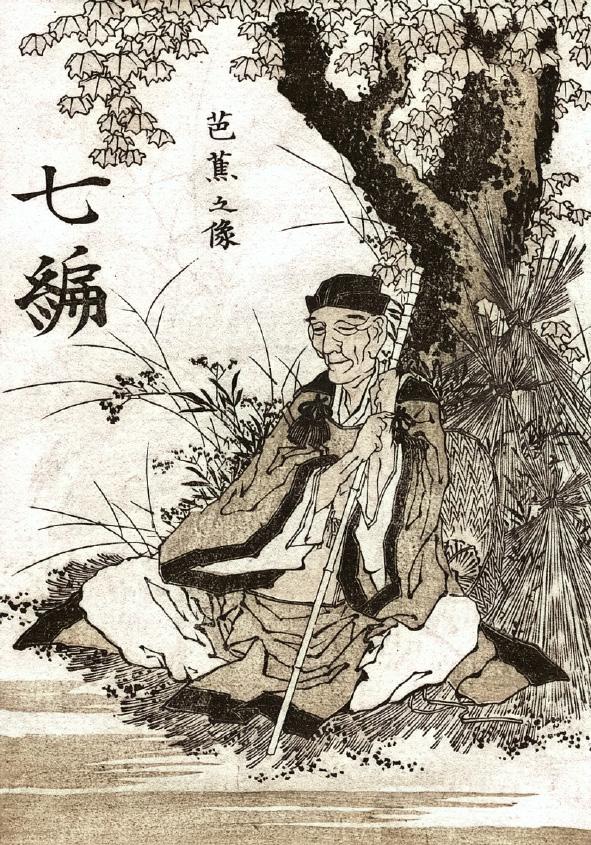
Estimate EUR 8,000
Starting price EUR 4,000
36
27
(Ritsuo, 1663-1747), sealed Kan 観 Japan, c. 1700, Edo period (1615-1868)
Portrait of Basho by Hokusai, late 18th century

A FINE RITSUO-STYLE STITCHED CHERRY-BARK AND CERAMIC-INLAID THREE-CASE LACQUER INRO WITH A HAWK AND SPARROW

Unsigned Japan, 18th century, Edo period (1615-1868)
Of oval section, formed from clear-lacquered cherry-bark, stitched at both edges. One side with a superbly inlaid ceramic hawk, confidently looking for its prey, perched on craggy rocks lacquered in thick takamaki-e with highlights of aogai. The fleeing sparrow in red takamaki-e with gold details and the leaves lacquered in gold hiramaki-e. Unsigned, however in the style of the famous lacquerer and ceramicist Ogawa Haritsu (Ritsuo, 1663-1747).
HEIGHT 8.3 cm, LENGTH 5.2 cm
Condition: Very good condition with minor wear to lacquer and typical losses to outer layer of the cherry bark. Presenting beautifully.
Provenance: Ex-collection Claudio Perino, a collector with a keen interest in Japanese, Chinese and Far Eastern cultures. His collection consists of over 2000 works of art, partly loaned to the Museum of Oriental Arts (MAO) in Turin, Italy and to the Museo delle Culture (MUSEC) in Lugano, Switzerland. An exhibition of Kakemono scroll paintings was on view in the MUSEC until end of April 2021.
Japanese mountain cherry, Yamazakura, is a wild species which has a strong vitality and bark that regenerates after being carefully stripped. The collected bark is dried for more than three years before it is whittled and polished by hand, cut to the appropriate shape, and glued to the surface of a wooden base using nikawa animal glue. Other techniques entail carving pre-assembled layers of cherry bark into small shapes and polishing them for jewelry and other uses.
Ogawa Haritsu (formerly often referred to outside Japan by his alternative name of Ritsuo) was among the first Japanese lacquer artists to establish an independent reputation outside of the hereditary craft dynasties of Kyoto, Edo, and Kanazawa. Following an early career as a haiku poet, he is thought to have first turned his attention to lacquer design in middle age and soon attracted a wide following thanks to his novel choice of subject matter and pioneering and imaginative use of unusual materials; at some point after 1710 he was hired by Tsugaru Nobuhisa (1669-1747), lord of a domain in northern Japan, for whom he worked until 1731.
Estimate EUR 5,000
Starting price EUR 2,400
38 28

A SUPERB AND RARE CERAMIC-INLAID LACQUER THREE-CASE INRO DEPICTING A SHISHI, SIGNED KAJIKAWA AND SEALED KAN
The lacquer work by the Kajikawa family, the ceramic-inlay by Ogawa Haritsu (Ritsuo, 1663-1747) or Mochizuki Hanzan (17431790), sealed Kan 観 and signed Maki-e 蒔絵 Kajikawa 梶川 saku 作 with seal Ei 榮 Japan, 18th century, Edo period (1615-1868)

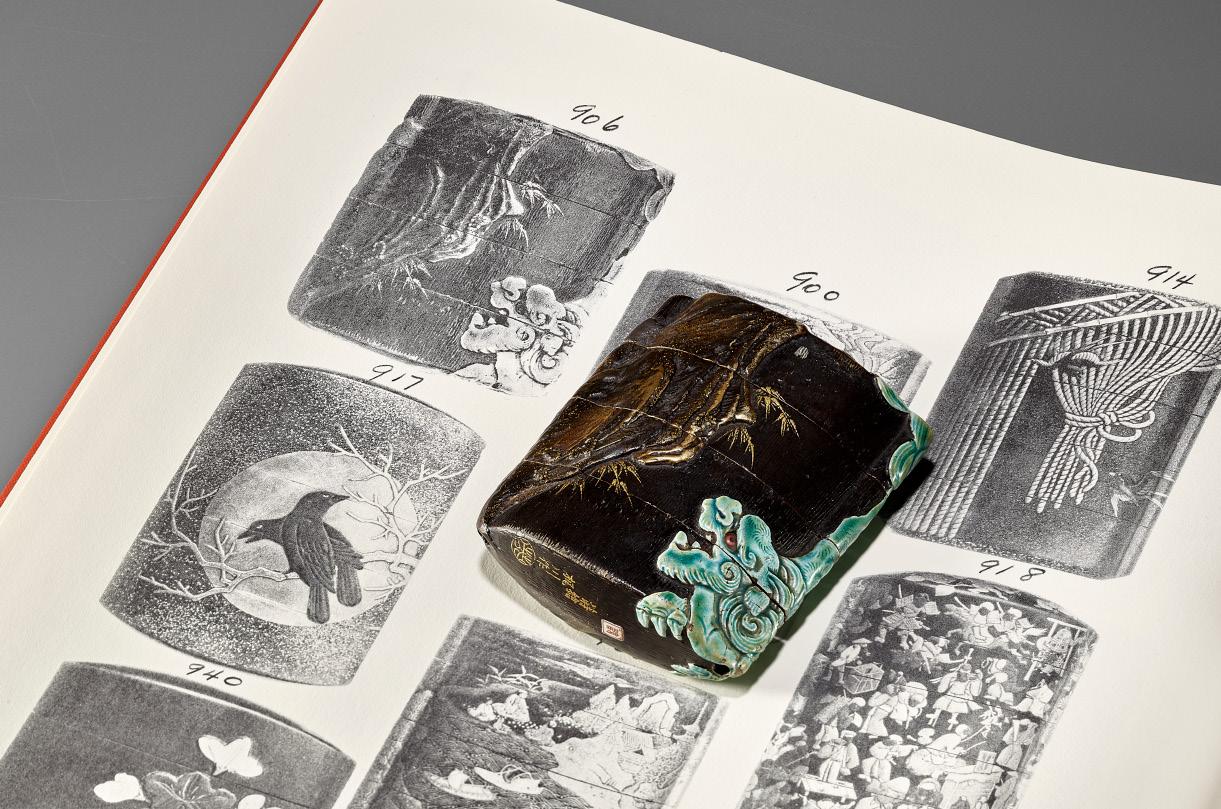
Published: Joly, Henri L. (1912) The W. L. Behrens Collection, Part 2, Lacquer and Inro, no. 906, illustrasted on pl. XLIV.
The boldly carved wood inro of almost square shape and oval section, bearing a beautiful, natural grain, lacquered in unusually thick takamaki-e with rich gold depicting a continuous image of a craggy rock with leafy hiramaki-e bamboo sprays in gold, next to an imposing snarling shishi, filling out the other half of the composition, inlaid in bright turquoise-blue ceramic. The image spilling over to the upper and lower area of the top and bottom case. Signed underneath Maki-e KAJIKAWA saku [the lacquer made by Kajikawa] with gold seal Ei and further with a red and white glazed ceramic seal KAN [for Ogawa Haritsu, Ritsuo]. The interior cases and rims of gold lacquer.
HEIGHT 7.5 cm, LENGTH 6.3 cm
Condition: Excellent condition with only very minor wear and expected firing flaws to the ceramic inlay.
Provenance: Ex-collection W. L. Behrens (1861-1913). Sold at Glendining & Co Auction,, 21 November 1946. A noted private collection, acquired from the above, assembled by the previous owner’s great-grandfather and thence by descent. With old collection labels to the top case.

The Kajikawa family are a famous dynasty of lacquerers founded in the 17th century in Edo. The combination of lacquer work by the Kajikawa family and ceramic-inlay by Ritsuo is very rare.
Ogawa Haritsu (formerly often referred to outside Japan by his alternative name of Ritsuo) was among the first Japanese lacquer artists to establish an independent reputation outside of the hereditary craft dynasties of Kyoto, Edo, and Kanazawa. Following an early career as a haiku poet, he is thought to have first turned his attention to lacquer design in middle age and soon attracted a wide following thanks to his novel choice of subject matter and pioneering and imaginative use of unusual materials; at some point after 1710 he was hired by Tsugaru Nobuhisa (1669-1747), lord of a domain in northern Japan, for whom he worked until 1731.
Mochizuki Hanzan, thought to have lived from 1743 to 1790, called himself Haritsu II and was a close follower of Ogawa Haritsu (16631747) though he was neither his son nor his pupil. His works are sometimes sealed ‘Kan’ and it has become a challenge for scholars and collectors to distinguish some of these works from those of Ogawa Haritsu.
AUCTION COMPARISON
For a related lacquer suzuribako with simialrily bright inlays, by Hanzan, and bearing a similar seal, see Zacke, Fine Japanese Art, 3 December 2021, Vienna, lot 165 (sold for EUR 50,560).
Estimate EUR 10,000
Starting price EUR 5,000
40 29
Portrait of Walter Lionel Behrens (1861-1913)


RITSUO: A MASTERFUL AND RARE INLAID TWOCASE INRO DEPICTING THE YOKAI BOX FROM THE SHITAKIRI SUZUME, WITH EN SUITE NETSUKE AND OJIME, THE NETSUKE BY OHARA
 MITSUHIRO
By Mochizuki Hanzan (1743-1790), signed Ritsuo 笠翁 and kakihan Japan, 18th century, Edo period (1615-1868)
MITSUHIRO
By Mochizuki Hanzan (1743-1790), signed Ritsuo 笠翁 and kakihan Japan, 18th century, Edo period (1615-1868)
The remarkable two-case inro of box shape, acting as a trompel’œil optical illusion, with a ‘hinged lid’ opening to reveal several yokai creatures, inlaid in stained horn, antler, amber, ceramic, and various metals. A rokurokubi-esque snail creature with a single cycloptic eye is seen to the very left, poking its long neck through a hole in the box, next to a praying mantis with gilt eyes, and two anthropomorphic frog-creatures to the right. The ground is lacquered in an attractive reddish-brown, simulating a basketweave design, the front decorated with a gold sparrow crest, a metalinlaid snail slithering through teared holes to either side of the inro and further with carved red lacquer flames emerging from within throughout the composition. A wasp and a butterfly are visible within the opening to the sides of the inro. With realistically modeled metal fittings posing as the hinges and closing mechanism of the box. Signed underneath in gold lacquer RITSUO with a red-lacquered kakihan, identifying the artist as Mochizuki Hanzan (Haritsu II, 1743-1790). The interior of dense nashiji with gold fundame rims.
With an en suite bone ojime depicting a stylized sparrow and a beautifully matching, thick manju netsuke carved from walrus tusk and depicting a sparrow above bamboo, executed in sumi-stained kebori, signed MITSUHIRO (Ohara Mitsuhiro, 1810-1875) and with the artist’s kakihan.
HEIGHT 6.6 cm, LENGTH 7 cm
DIAMETER (the netsuke) 4.5 cm
Condition: Very good condition. Only minor wear and rubbing to lacquer, some typical minuscule losses along the edges, some light surface scratches to the underside.
Mochizuki Hanzan, thought to have lived from 1743 to 1790, called himself Haritsu II and was a close follower of Ogawa Haritsu (16631747) though he was neither his son nor his pupil. The kakihan (artist’s cursive monogram) on the present inro is a close match to a kakihan seen on an inro bearing his signature, the signature illustrated in Wrangham, E. A. (1995) The Index of Inro Artists, p. 67.
The inro depicts the famous treasure box from the Tongue-Cut Sparrow (Shitakiri Suzume), which was opened by the story’s culprit, Arababa, and contains a host of supernatural bakemono and yokai. The manju netsuke and ojime are matching as well, both depicting sparrows.
Estimate EUR 15,000
Starting price EUR 8,000
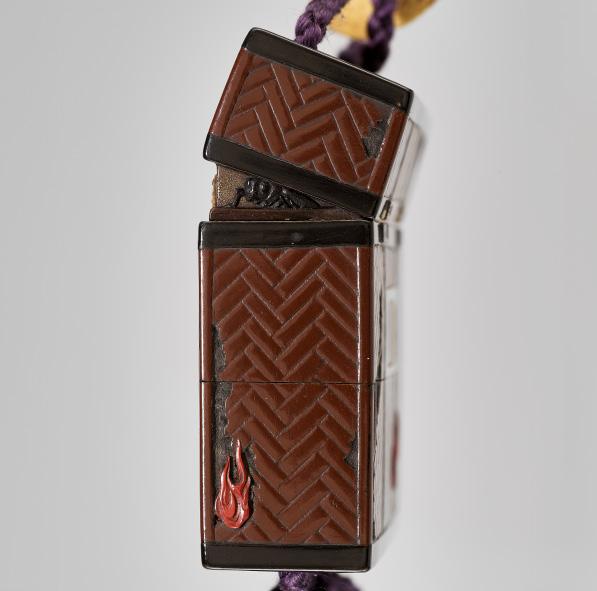
43 30
MOEI: A SUPERB FOUR-CASE TOGIDASHI LACQUER INRO DEPICTING A DRAGONFLY
 By Nakaoji Moei, signed Moei 茂永 Japan, late 18th to early 19th century, Edo period (1615-1868)
By Nakaoji Moei, signed Moei 茂永 Japan, late 18th to early 19th century, Edo period (1615-1868)
Of upright rectangular form and oval section, bearing a lustrous roiro ground, lacquered in red hiramaki-e and gold and silver togidashi-e, as well as some highlights of gold sprinkles. The front with a luminescent dragonfly sitting atop a blossoming flower, the reverse with further blooms and buds on a sprig. The red and gold in sharp contrast to the stunning roiro ground. The interior compartments of nashiji with gold fundame edges. Signed to the bottom MOEI in gold lacquer.
HEIGHT 7.7 cm, LENGTH 5.2 cm
Condition: Very good condition with minor wear to the edges and some minuscule wear to the lacquer.
Provenance: Ex collection Jay Hopkins, Lynchburg, Virginia, Unites States. Two old collector’s labels, ‘HOPKINS 6853’ and ’25.’
Togidashi-e is a variety of the ‘maki-e’ decorative technique in lacquer, first popular in the Heian period. After hardening, the low relief sprinkled design and ground is covered in transparent or black lacquer, then polished down with charcoal until the design is flush with the new ground.
Moei was a togidashi specialist, who worked from the late 18th to early 19th century, and is noted as one of the most beguiling practitioners of soft-edged, ‘boneless’ togidashi techniques, often using bold, warm colors for his bird and animal subject matter, as seen in the present lot.
AUCTION COMPARISON
Compare a related four-case lacquer inro by Moei depicting an otter swimming underwater at Christie’s, Japanese and Korean Art, 20 March 2007, New York, lot 156 (sold for USD 9,600).

Estimate EUR 8,000
Starting price EUR 4,000
44 31

A VERY RARE THREE-CASE TOGIDASHI LACQUER INRO DEPICTING A KITSUNE LURED INTO A FOX TRAP

Unsigned Japan, 18th-19th century, Edo period (1615-1868)


The wide-bodied three-case inro bearing a roiro ground with finely sprinkled silver and gold lacquer, decorated in superb togidashi-e with gold and silver takamaki-e and hiramaki-e, depicting a scene from the Kyogen play Tsurigitsune, the fox disguised as a priest, a hyotan (double gourd) tied to its waist, emerging from the mist amid tall grasses and ferns, looking towards a trap with a rat as the bait, all beneath the crescent moon. The interior cases of dense nashiji with gold fundame rims. With a polychromed wood ittoboristyle netsuke.
HEIGHT 7.8 cm, LENGTH 8.5 cm
Condition: Very good condition with only very minor expected wear. Some light warping to the top case.
Provenance: From an old Geneva collection, with an old collection number and label to the interior of the top case.
Kitsune are creatures imbued with magical powers and are known to have the ability of shapeshifting. They are also believed to be animated by the devils.
The inro depicts a scene from the Kyogen play Tsurigitsune (‘Fox trapping’), in which a fox hunter is visited by his uncle, the priest Hakuzosu, who lectures his nephew on the evils of killing foxes. The hunter is nearly convinced, but after the priest departs, he hears the cry of the fox and realizes it wasn’t his uncle at all but a fox in disguise. The fox resumes his natural form and reverts to his wild ways, takes the bait in a trap, and is captured by the fox hunter.
Estimate EUR 6,000
Starting price EUR 3,000
46 32
The Fox Dancing before a Fox Trap in the Kyogen Play Tsurigitsune, by Utagawa Hiroshige, c. 1840
The Cry of the Fox, by Yoshitoshi, 1886
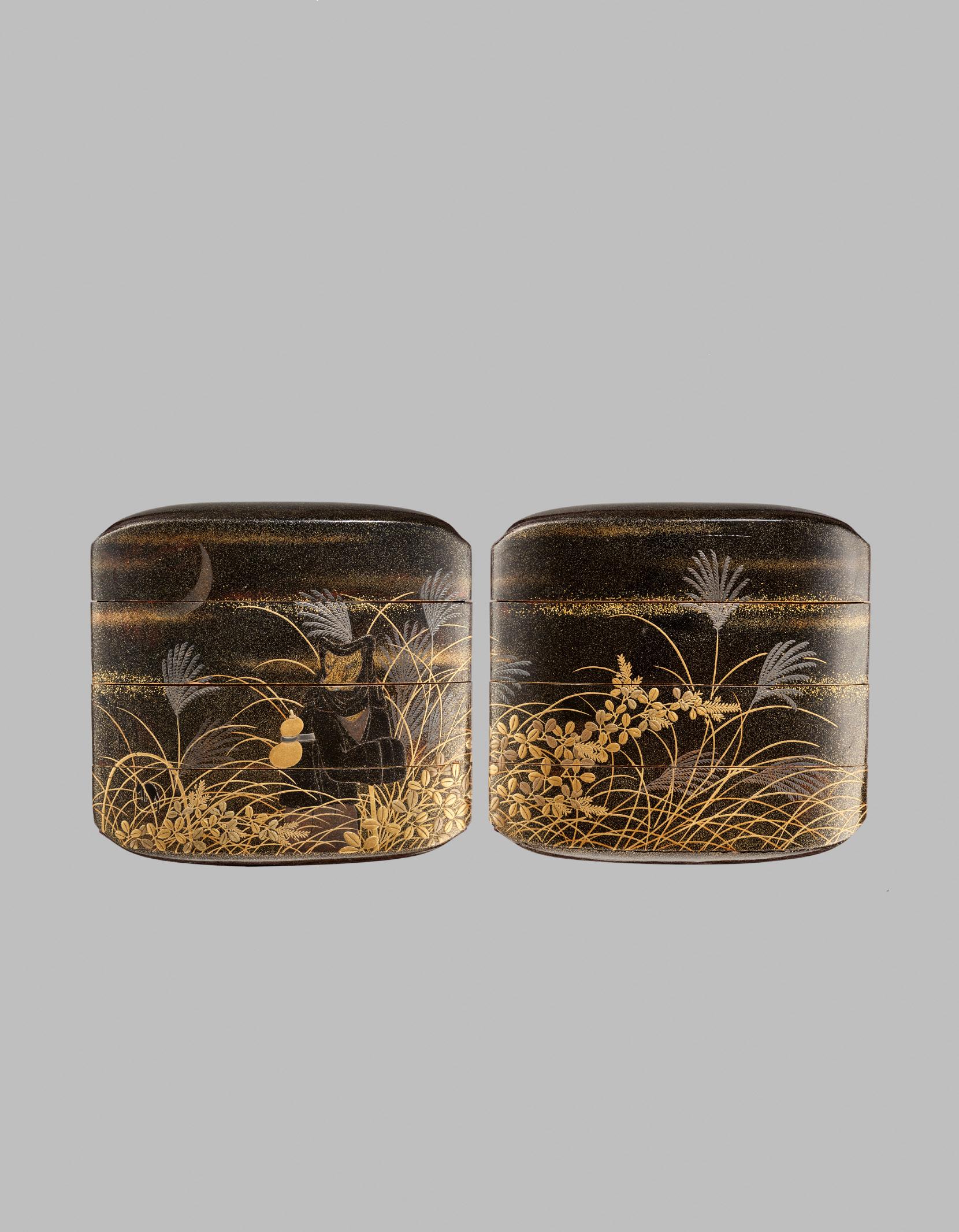
A FINE FIVE-CASE LACQUER INRO OF AN IDYLLIC LANDSCAPE
Unsigned Japan, 18th century, Edo period (1615-1868)

Of upright rectangular form and oval section, bearing a lustrous roiro ground, finely decorated in gold takamaki-e and hiramaki-e with nashiji and kirigane to depict an imposing, undulating mountainous landscape following the path of a meandering river. Several pavilions and houses dot the landscape, a Tori gate to the distance, some details rendered in red and brown lacquer. The scenery with a flush river which supports fishermen who haul their catch to the shore in several boats, few geese fly nearby, as an elderly gentleman crosses a bridge. The interior compartments of nashiji with gold fundame edges. With mixed-metal ojime of floral design.
HEIGHT 10.3 cm, LENGTH 5.2 cm 0
Condition: Very good condition with minor wear and typical losses to kirigane and lacquer along the edges.
Provenance: From a noted private collection in Geneva, Switzerland, assembled since the 1960s, and thence by descent. An old collector’s label to base, ‘Art Ancien Chine & Extr-Orient Geneva: 2460, THAA’ and ‘2460 HIRSSAN.’ And two more labels inscribed, ‘Five case, black lacquer inro decorated gold takamaki-e hiramaki-e, togidashi and […] landscape pf water, pavilions, boats, rocks, trees’ and ‘2460/328.’ An important part of this collection was on permanent loan and was exhibited over several decades at the Asia-Africa Museum in Geneva.

AUCTION COMPARISON
Compare a closely related lacquered inro of a continuous landscape village scene of hills and trees by a river, by the Kajikawa family, at Bonhams, Fine Japanese Art, 16 May 2013, lot 202 (sold for GBP 3,125).
Estimate EUR 4,000
Starting price EUR 2,000
48 33
A RARE STITCHED CHERRY BARK THREE-CASE LACQUER INRO WITH CHERRY BLOSSOMS
Unsigned Japan, c. 1800, Edo period (1615-1868)
Of upright rectangular form and oval section, the inro formed from clear-lacquered cherry-bark, stitched at both edges. The design featuring sprigs of cherry-blossoms with buds and blooms in gold and silver takamaki-e on one side, the other similarly lacquered with cherry stems and leaves. The top, base, and interior rims lacquered in gold fundame. With a carved wood ojime decorated with reishi fungi and with gilt cord holes.


HEIGHT 8.3 cm, LENGTH 4.8 cm
Condition: Good condition with typical losses and minimal wear. One chip to the edge of the bottom case.
Provenance: From the collection of Arend Louis Serné. Arend Louis Serné (1925-2021) was the fourth-generation owner of the firm A. Serné & Son, Costumiers, located on the Groenburgwal, Amsterdam, Netherlands, established in 1866. An avid piano player, he was also fond of modern literature, and a passionate collector of inro. He started his inro collection in the late 1970s.
Japanese mountain cherry, Yamazakura, is a wild species which has a strong vitality and bark that regenerates after being carefully stripped. The collected bark is dried for more than three years before it is whittled and polished by hand, cut to the appropriate shape, and glued to the surface of a wooden base using nikawa animal glue. Other techniques entail carving pre-assembled layers of cherry bark into small shapes and polishing them for jewelry and other uses.
Estimate EUR 4,000
Starting price EUR 2,000
49 34
TOSHI: A FINE THREE-CASE LACQUER INRO DEPICTING A VIEW OF THE KATSURA RIVER
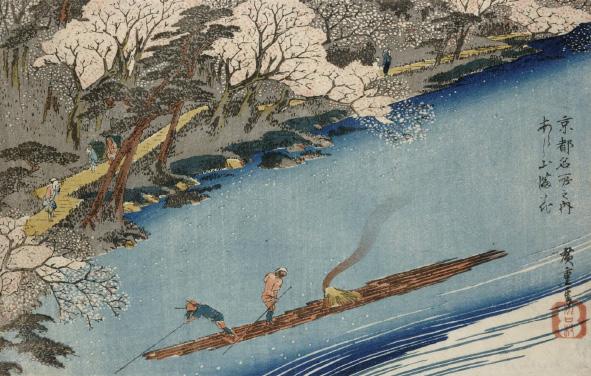
 By Iizuka Toyo III, signed Toshi 花押 with kakihan Japan, c. 1800, Edo period (1615-1868)
By Iizuka Toyo III, signed Toshi 花押 with kakihan Japan, c. 1800, Edo period (1615-1868)
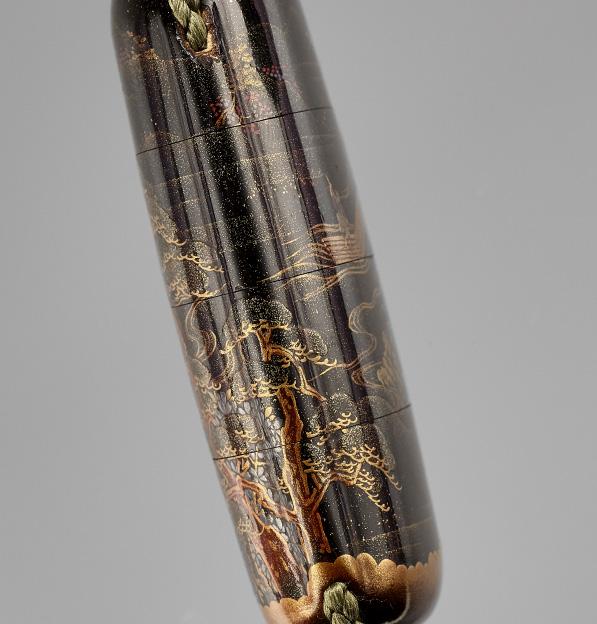
Of upright oval shape, the three-case inro bearing an attractive roiro ground, lacquered in colored hiramaki-e and togidashi-e with rich gold, depicting a scene of the Katsura river at Arashiyama, Kyoto, with an idyllic scene of two men steering a raft to one side and with a bridge below a towering pine tree and cherry blossoms, a hilly landscape in the distance to the other. Signed in gold lacquer to the underside TOSHI and kakihan. The interior cases of nashiji with gold fundame rims. With an amber ojime.
HEIGHT 7.5 cm, LENGTH 5.8 cm
Condition: Excellent condition with only very minor typical wear.
Toshi (Iizuka Toyo III) was a fine lacquerer who is said to have learnt the art as a pupil of Toyo(sai) I and to have followed Toyo II (Toju(sai)) in the family succession. He excelled at a variety of different techniques, togidashi being one of them, as is evident on the superb use on the present inro. For more information on the artist see Wrangham, E. A. (1995) The Index of Inro Artists, pp. 304-305, where also identical kakihan (artist’s cursive monogram) are illustrated.
Estimate EUR 4,000
Starting price EUR 2,000
50 35
Rafting on the Katsura river, Utagawa Hiroshige, c. 1834
KAJIKAWA: A FINE FOUR-CASE LACQUER INRO WITH CRANES

By a member of the Kajikawa family, signed Kajikawa 梶川 saku 作 with seal Ei 榮 Japan, 19th century, Edo period (1615-1868)
Of upright rectangular shape and oval section, bearing a lustrously polished roiro ground, lacquered in gold and silver takamaki-e, with some red lacquer, and further embellished with a profusion of kirigane. Depicted are two cranes to either side, flying or bellowing at the sky, framed by richly decorated landscapes with waterfalls, a stream, craggy rocks, hills, camellia, and pine. Signed to the underside KAJIKAWA saku [made by Kajikawa] with red tsubo (pot) seal Ei. The interior cases of nashiji with gold fundame rims. With an associated wood storage box (tomobako).
HEIGHT 7 cm, LENGTH 5 cm
Condition: Excellent condition with only very minor typical wear, particularly along the edges of the risers.
Provenance: Ex-collection J. Bellhouse Gaskell, collection no. 188, with an old label to the top case ‘G188’.

Estimate EUR 3,000
Starting price EUR 1,500
51
36
A FINE TOGIDASHI FIVE-CASE INRO DEPICTING PHEASANTS AND TURTLE DOVES
Unsigned Japan, late 18th century, Edo period (1615-1868)
Of rectangular form, finely decorated in togidashi and light nashiji clouding depicting a pheasant and hen beneath a tall bush clove with softly rounded leaves. The reverse with three turtle doves perched in a leafless tree with a gnarled trunk flanked by two taller trees, each trunk decorated with kirigane flakes. The interior with a dense nashiji ground and gold fundame edges.

HEIGHT 8 cm LENGTH 5.1 cm
Condition: Very good condition with minor wear and minuscule chips to the lower edge of the bottom case.
Provenance: Lempertz, 30 November 1991, Cologne, lot 981. A private collection in Munich, Germany, acquired from the above. The interior with an old collector’s label, ‘INRO, 6tlg., abgesetzte
Schnurführung. Außen allseitig Schwarzlack mit locker gruppiertem jashiji. Darin, auf beide Seiten übergreifend, Ausschnitt einer herbstliche Landschaft mit Fasanenpaar (eine Seite) und deren, auf einem Baumstamm hockenden Jungvögel (andere Seite) in mit Rot und feinen Gold-togidashi. Innen heller, feinkörniger jashiji. Ende 18. Jh. 7,9 x 5 cm. Geringfügige Gebrauchsspuren. 981.‘
Togidashi is a variety of the ‘maki-e’ decorative technique in lacquer, first popular in the Heian period. After hardening, the low relief sprinkled design and ground is covered in transparent or black lacquer, then polished down with charcoal until the design is flush with the new ground.
The bush clove blooms during the late summer, early fall, suggesting the motif depicts the changing seasons from fall to winter. The turtle dove (kame hato) which roost in the wintery landscape are a symbol of loyalty and fertility, while pheasant were a symbol of imperial elegance.
Estimate EUR 3,000
Starting price EUR 1,500
52 37
SEKIGAWA KATSUNOBU: A FINE THREE-CASE LACQUER INRO OF PLOVERS ABOVE WAVES

By Sekigawa Katsunobu, signed Sekigawa 関川 saku 作 and sealed Katsunobu Japan, early 19th century, Edo period (1615-1868)
The three-case inro lacquered in gold takamaki-e with migrating plovers (chidori) in flight against mura-nashiji clouds, the turbulent water below rendered in gold hiramaki-e with gold and silver togidashi. The interior compartments of nashiji with gold fundame edges. With a reticulated metal ojime.

HEIGHT 7.3 cm, LENGTH 7.1 cm
Condition: Very good condition with rubbing to the side where the edges meet, revealing the fundame underneath. For further information on the artist see Earle, Joe [ed.] (1995) The Index of Inro Artists, p. 118.
MUSEUM COMPARISON
A closely related lacquered inro of a sleeping cat by Sekigawa is in the Rijksmuseum, Amsterdam, object no. AK-MAK-868.
Estimate EUR 3,000
Starting price EUR 1,500
53
38
A FINE FIVE-CASE LACQUER INRO DEPICTING AN EAGLE AND MONKEY
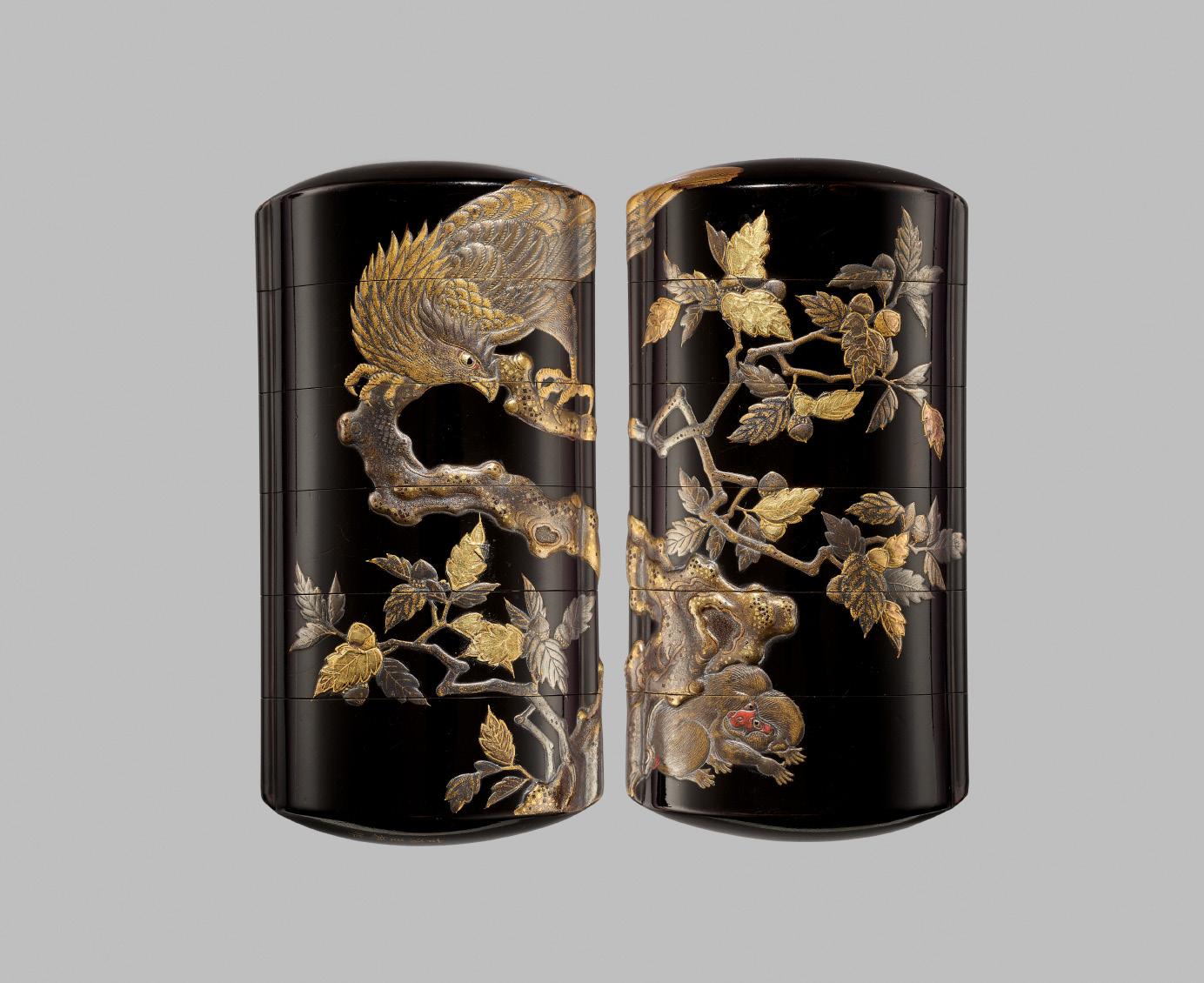 By Koma Koryu, signed Koma Koryu 古満巨柳 Japan, 19th century, Edo period (1615-1868)
By Koma Koryu, signed Koma Koryu 古満巨柳 Japan, 19th century, Edo period (1615-1868)
Of tall upright form with an ellipsoid profile, bearing a lustrous roiro ground lacquered in gold and silver takamaki-e with hiramaki-e detailing as well as gold leaf and kirigane along the gnarled branch of the oak tree. Decorated with a fierce eagle with frilled feathers standing on a leafy oak branch carrying acorns. The attention of the eagle is captured by a small monkey cowering beneath the branches, its frightened face finely lacquered in red. The underside signed in gold KOMA KORYU saku [made by Koma Koryu]. The interior cases of nashiji with gold fundame edges.

HEIGHT 9.9 cm, LENGTH 4.9 cm
Condition: Very good condition with minor wear, typical wear to the gold-leaf inlays, and slight rubbing to the lacquer along the edges.
Koma is the family name of one of the most famous dynasties of lacquer artists. The dynasty was founded by Koma Kyui who worked in Edo in the 17th century, and his descendants were lacquerers of the court and shogunate until well into the 19th century.
Estimate EUR 4,000
Starting price EUR 2,000
54 39
A FIVE-CASE LACQUER INRO DEPICTING A CHARMING WINTER SCENE
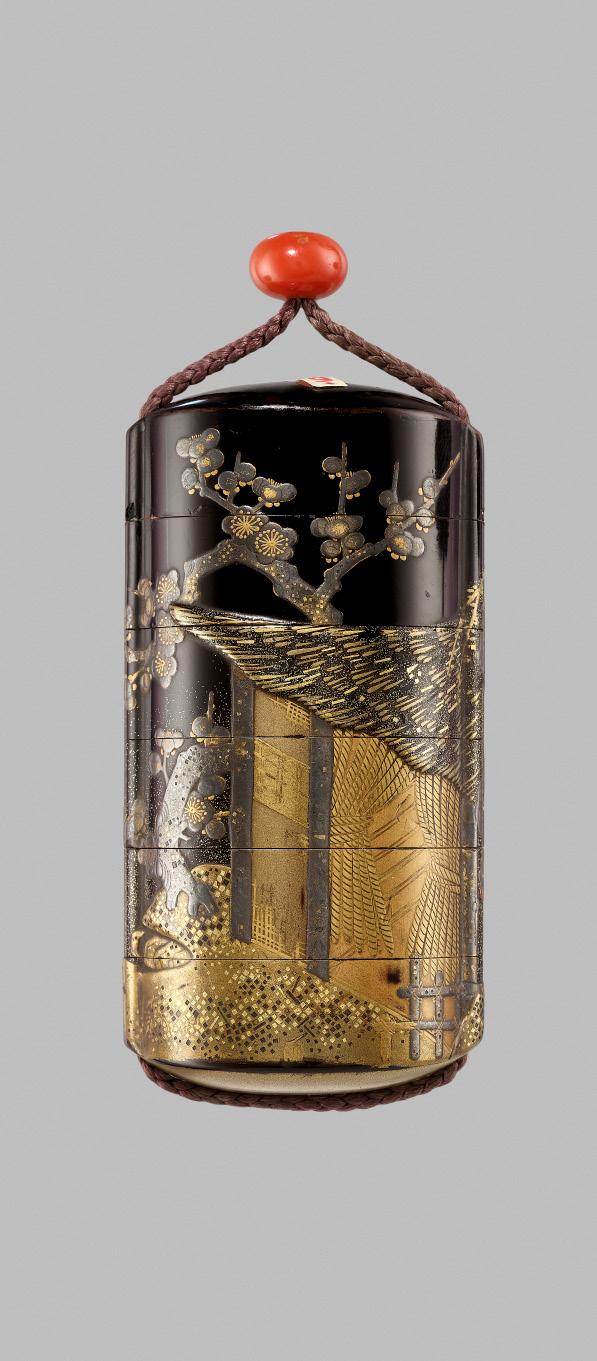

Unsigned Japan, 19th century, Edo period (1615-1868)
Of upright shape and lenticular section, bearing a lustrous roiro ground, lacquered in gold and silver takamaki-e with some kirigane, depicting an egret lifting one leg to warm itself below a snowcovered willow, the reverse showing a fisherman’s hut below a snowy plum tree, the cool wind rushing into the hut. The interior cases of nashiji with gold fundame rims. With a coral ojime.
HEIGHT 8 cm, LENGTH 5.1 cm
Condition: Very good condition with minor wear and minuscule chips to the lower edge of the bottom case.
Provenance: Old French private collection, with two old collection numbers to the top case and interior of the top case, ‘9’ & ‘209’.
Estimate EUR 2,000
Starting price EUR 1,000
55 40
KAJIKAWA: A SUPERB FOUR-CASE LACQUER INRO WITH HAWKS AND CHERRY BLOSSOMS
By a member of the Kajikawa family, signed Kajikawa 梶川 saku 作 with seal Ei 榮 Japan, 19th century, Edo period (1615-1868)
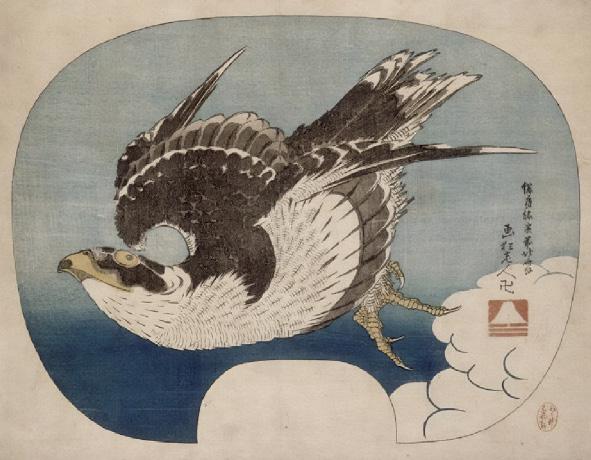
Of upright rectangular shape and oval section, bearing a fine gold kinji ground, beautifully polished and lustrous, lacquered in gold takamaki-e with some gold leaf inlay depicting to one side a hawk perched on the branch of a blossoming sakura (cherry) tree, the tree embellished with kirigane, the eyes of the hawk double inlaid, the verso similarly decorated with a second hawk in mid-flight. The interior cases of nashiji with gold fundame rims. Signed underneath in gold lacquer KAJIKAWA saku [made by Kajikawa] and with the red tsubo (pot) seal Ei. With a ceramic ojime with gilt floral décor.

HEIGHT 8.7 cm, LENGTH 5.3 cm
Condition: Very good condition with only minor wear. Some light surface scratches and rubbing to lacquer.
Provenance: From the collection of Arend Louis Serné. An old collector’s label to the interior, ‘G 188.’ Arend Louis Serné (19252021) was the fourth-generation owner of the firm A. Serné & Son, Costumiers, located on the Groenburgwal, Amsterdam, Netherlands, established in 1866. An avid piano player, he was also fond of modern literature, and a passionate collector of inro. He started his inro collection in the late 1970s. At that time, he entered the gallery Aalderink Oriental Art along the Spiegelgracht in Amsterdam and was immediately captivated by the beauty of inro. He began his collection with three simple specimens but hoped to own more. He remarked, “Oh that’s nothing, a decent collection must be about a hundred pieces!” And collect he did. Arend was not concerned with the signature or the rarity, but with the intrinsic poetic beauty embodied in this very Japanese art form.
Estimate EUR 6,000
Starting price EUR 3,000
56 41
Hawk in Flight, by Katsushika Hokusai
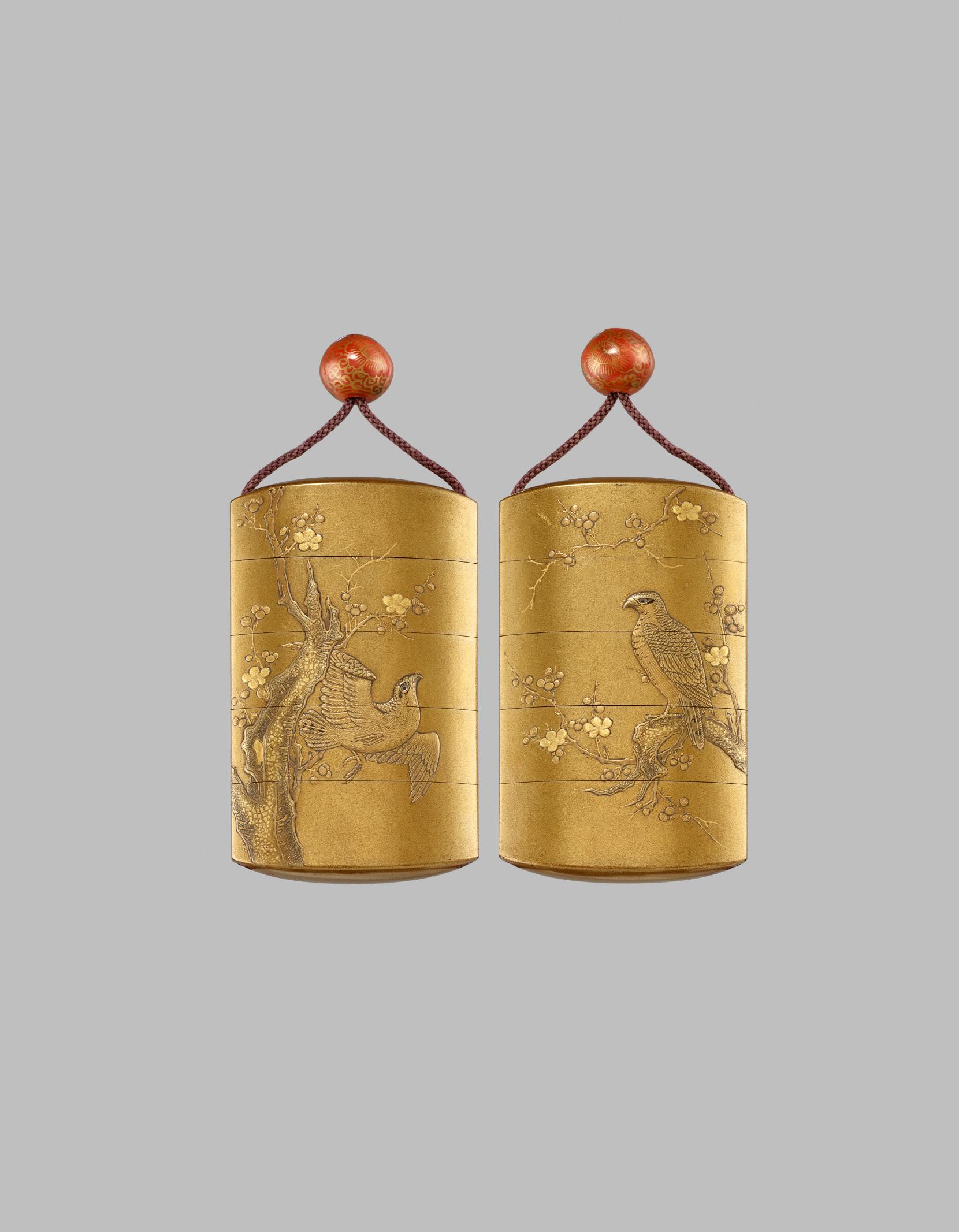
JOKASAI: A FINE FOUR-CASE GOLD LACQUER INRO DEPICTING A FALCON AND HERON


Lineage of Yamada Jokasai, signed Jokasai 常嘉齋 Japan, 19th century, Edo period (1615-1868)
Of upright rectangular form and oval section, bearing a bright gold nashiji ground, finely worked in gold and silver takamaki-e and hiramaki-e, with some inlays, depicting two large roundels to either side. The larger roundel to the front with a silver-lacquered falcon gripping the neck of a heron surrounded by leaves inlaid with tsuishu (carved red lacquer), shibuichi, bright turquoise enamels, and mitsuda (pewter), some with gold hiramaki-e veins, all set on a fine gyobu-nashiji ground. The smaller roundel to the reverse decorated with rich gold takamaki-e peony blossoms and butterflies with mother-of-pearl inlaid wings, and a large white ceramicinlaid peony blossom set on a cloudy nashiji ground. The interior lacquered in silver. Signed underneath in gold lacquer JOKASAI.
HEIGHT 8.5 cm, LENGTH 6.7 cm
Condition: Good condition with minor wear, typical losses to the gyobu-nashiji, minor discoloration to the lacquer ground, a minor dent to the upper case, a small crack to the second case, and typical rubbing to the inner silver lacquer. Overall presenting very well.
Provenance: From an old French private collection, with an old label to the interior of the top case.

The Yamada Jokasai lineage lasted until the end of the Edo period. The first Yamada Jokasai lived in Tokyo in the late 17th century and worked for the shogunate, originally at the Kajikawa school. He crafted inro and kobako alongside the famous Koami Choho, later breaking off to establish his own school in Tokyo.
LITERATURE COMPARISON
Compare a related inro with similar inlays, signed Jokasai, illustrated in Moss, Sydney L. (2014) Lac Lacquer Lacquest, p. 128-129, no. 34.
Estimate EUR 4,000
Starting price EUR 2,000
58
42
43
A FINE INLAID AND LACQUERED THREE-CASE INRO WITH CARP
Unsigned Japan, 18th century, Edo period (1615-1868)

Bearing a roiro ground and lacquered in fine gold hiramaki-e, with some kirigane highlights, further embellished with various inlays such as gilt metal, silver, mother-of-pearl, hardstone, tortoiseshell, and horn, depicting a carp swimming amongst aquatic plants and reeds. The interior cases lacquered in black. With an aventurinesplashed glass ojime.
HEIGHT 8.7 cm, LENGTH 5.3 cm
Condition: Good condition with minor wear and rubbing to lacquer as is to be expected. A small chip to the edge of the cord runner of the top case. Some light crackling to the sides. The top with remnants from an old label and some light bruising from contact with the ojime. Overall presenting beautifully.
Provenance: Ex-collection Rabeuf, collection no. 1426. With some old labels to the interior of the top case. The Rabeuf collection of Japanese art was published in 1909.
MUSEUM COMPARISON
Compare a related lacquer inro with a similar, by Shomosai, in the collection of The Metropolitan Museum of Art (The MET), New York, Accession number 13.67.21.

Estimate EUR 3,000
Starting price EUR 1,500
59
44
A SUPERB INLAID THREE-CASE LACQUER INRO DEPICTING DIVING FISHERMEN

Unsigned Japan, 19th century
Of rectangular form and oval section, decorated with nashiji waves on a roiro ground and further embellished with various inlays including tortoiseshell and marine ivory. The front depicting a fisherman cradling a large fish with double-inlaid eyes, as he treads water in rounding waves above a paneled fish trap inlaid with mother-of-pearl and gold takamaki-e. The reverse depicts a fisherman partly submerged underwater with his inlaid feet sticking out as he is diving towards the trap, which is laced together by a string of gold hiramaki-e. The net continuous along the base of the inro. The interior cases of nashiji.
HEIGHT 6.5 cm, LENGTH 5.6 cm
Condition: Good condition with minor wear, typical wear to the edges, and minor losses to the mother-of-pearl inlay.
Provenance: From an old English private collection. The interior with two old collector’s numbers, ‘558’ and ‘583.’
The inro is designed as a continuous frame with both fishermen diving for fish in the same trap net. The inro exhibits a variety of different techniques, the most impressive being the togidashi-e used for the parts of the man submerged in water, which is in deep contrast to his inlaid feet. The inlaid marine ivory of the surfaced sections of the swimmers is finely stained to highlight their muscular arms and legs.
Estimate EUR 6,000
Starting price EUR 3,000
60

HOYU: A FINE SHIBAYAMA INLAID GOLD LACQUER FOUR-CASE INRO WITH HAWKS
By Hoyu, signed Hoyu 豊遊 saku 作 Japan, second half of 19th century
Published: E. A. Wrangham, The Index of Inro Artists, Harehope, Northumberland, 1995, p. 324, EW 981 (only the signature illustrated).
Of lenticular form, bearing a lustrous gold kinji ground, lacquered and inlaid on either side with a hawk tethered to a perch, suspended with brocade cloths decorated with formal designs, in gold takamaki-e and hiramaki-e, the birds inlaid with raden (shell) in the Shibayama-style. Signed underneath in gold HOYU saku [made by Hoyu]. The interior cases of nashiji with gold fundame rims. With a matching mixed metal ojime worked in takazogan with a bird on a branch.

HEIGHT 8.5 cm, LENGTH 5.5 cm
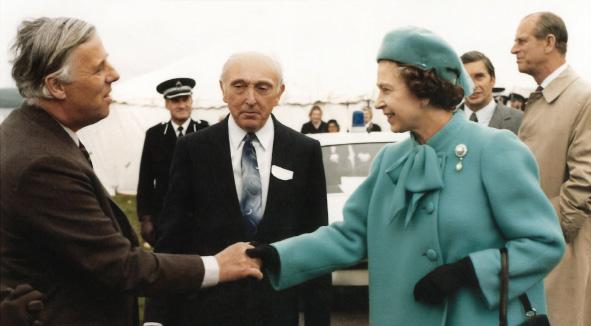
Condition: Very good condition with some light chipping to the edges of the risers and some minor general wear.
Provenance: Collection Edgar Franckel, sold at Sotheby’s London in 1969. Ex-collection Edward A. Wrangham, collection no. 981, acquired from the above. Sold at the latter’s fourth sale, Bonhams, London, 5 November 2014, lot 170 (sold for GBP 2,000). Edward A. ‘Ted’ Wrangham (1928-2009) formed one of the most important collections of Japanese Art in modern times. His reference book ‘The Index of Inro Artists’ (1995) is considered one of the most important English-language studies on Japanese lacquer ever published.
Estimate EUR 3,000
Starting price EUR 1,500
45
Edward ‘Ted’ Wrangham with Her Majesty Queen Elizabeth II, 1980
A FINE LACQUER FOUR-CASE INRO DEPICTING SHISHIMAI DANCERS, WITH EN SUITE NETSUKE

Unsigned Japan, 19th century, Edo period (1615-1868)
Of upright rectangular form and oval section, the four-case inro bearing a beautifully dense gyobu nashiji ground, finely decorated in red and gold takamaki-e with mother-of-pearl inlays to depict shishimai dancers. One side decorated with one dancer bent forward, the hands reaching to beat the drum, as his hips sway to the music. The drum-shell decorated with a manji-diapered ground, and the iridescent robe highlighted with foliate medallions in hiramaki-e. The reverse similarly decorated with another dancer, dressed in striped lacquer pants, as he peeks through the opening in the shishi mask. The interior cases of nashiji with gold fundame rims.
With an amber ojime The en suite Edo school wood netsuke carved as a seated shishimai dancer.

HEIGHT 7.4 cm, LENGTH 6.8 cm
Condition: Excellent condition with only minor wear.
The shishi masked dance (shishimai) is performed to ward off disease and calamity. It originated as a religious ceremony but the excitement of the dance, the music, and the rhythms increased over the centuries, so that over time it was performed for entertainment rather than ritualistic purposes.
Estimate EUR 3,000
Starting price EUR 1,500
63 46

64
KOMA SADAHIDE: A SUPERB INLAID FIVE-CASE LACQUER INRO DEPICTING DEERS IN NARA PARK
By Koma Sadahide, signed Koma Sadahide 古満貞榮 Japan, 18th-19th century, Edo period (1615-1868)
Of upright form and lenticular profile, bearing a lustrously polished roiro ground, the front decorated with a deer couple below temple lanterns and falling maple leaves, the stag executed in colored togidashi beautifully contrasting against his mother-of-pearl deer companion. The leaves are lacquered in gold hiramaki-e or inlaid with motherof-pearl or horn. The lanterns are, like the stag, lacquered in gold togidashi-e. The verso similarily decorated with a large stag inlaid in buffalo horn with antler horns. Signed underneath in gold characters KOMA SADAHIDE. The interior cases of nashiji with gold fundame rims.

With a reticulated metal ojime and a two-part ryusa manju netsuke, one side carved in antler with billowing clouds and reishi, and the other side of metal and depicting a ho-o (phoenix) with a kiri (paulownia) sprig in its mouth, the details gilt.
HEIGHT 9 cm, LENGTH 4.5 cm
DIAMETER (the netsuke) 4 cm
Condition: Very good condition with minor typical wear, particularly along the edges of the risers. The manju netsuke with minor wear to gilt.
Provenance: From a noted private collection in Geneva, Switzerland, assembled since the 1960s, and thence by descent. An old collector’s label to the base, ‘Art Ancien Chine & Extr-Orient Geneva’. An important part of this collection was on permanent loan and was exhibited over several decades at the AsiaAfrica Museum in Geneva.
Estimate EUR 5,000
Starting price EUR 2,400
65 47
KANSHOSAI TOYO: A SUPERB TWO-CASE LACQUER INRO WITH HORSES AND BLOSSOMING CHERRY TREE
By Kanshosai
Toyo (Iizuka Toyo I) or a close follower, signed Kanshosai 觀松齋
Japan, late 18th to early 19th century, Edo period (1615-1868)
The wide-bodied two-case inro bearing a fine roiro ground and lacquered in gold hiramaki-e with calligraphically cut raden (shell) in the Somada-style, depicting a mare feeding its young, the raden shell of the mother purposely worn away and filled in with kinpun to give the appearance of an old Somada-style inro. The beautifully contrasting verso with an opulent, flowering cherry tree executed in thick gold takamaki-e against a stunning nashiji ground and with some sparse kirigane. Signed underneath in gold lacquer KANSHOSAI (Iizuka Toyo). The bottom case with a central divider and of nashiji, the top case of gold fundame. With a lacquered wood ojime.

HEIGHT 5.6 cm, LENGTH 7.8 cm
Condition: Very good condition with only very minor wear and few light scratches.
Provenance: From the collection of Arend Louis Serné. Arend Louis Serné (1925-2021) was the fourth-generation owner of the firm A. Serné & Son, Costumiers, located on the Groenburgwal,
Amsterdam, Netherlands, established in 1866. An avid piano player, he was also fond of modern literature, and a passionate collector of inro. He started his inro collection in the late 1970s. At that time, he entered the gallery Aalderink Oriental Art along the Spiegelgracht in Amsterdam and was immediately captivated by the beauty of inro. He began his collection with three simple specimens but hoped to own more. He remarked, “Oh that’s nothing, a decent collection must be about a hundred pieces!” And collect he did. Arend was not concerned with the signature or the rarity, but with the intrinsic poetic beauty embodied in this very Japanese art form.
Iizuka (Kanshosai) Toyo was a distinguished lacquerer and inro decorator during the second half of the 18th century in Edo. He had many followers and used a wide range of techniques. The boldness and originality of the design may indicate an original work by this artist. For more information on the artist see Wrangham, E. A. (1995) The Index of Inro Artists, pp. 312-313.
MUSEUM COMPARISON
Compare a related lacquer inro with a similar design of horses, by Jokasai, in the collection of The Metropolitan Museum of Art (The MET), New York, Accession number 13.67.54.

Estimate EUR 4,000
Starting price EUR 2,000
66
48


JOKASAI: A SUPERB FOUR-CASE LACQUER INRO DEPICTING SHISHI
Lineage of Yamada Jokasai, signed Jokasai 常嘉齋 Japan, late 18th to early 19th century, Edo period (1615-1868)
The four-case inro bearing a neatly polished wood ground with a heightened grain, lacquered in thick gold takamaki-e with some silver and gold leaf inlay, depicting a large shishi holding a peony in its mouith, the eyes inlaid in mother-of-pearl. The verso with a further prancing shishi, turning back and snarling at its bushy tail, its visible eye inlaid in bright-blue ceramic. The interior risers are decorated in togidashi-e, hiramaki-e, and nashiji with concentric wave designs and stylized cherry blossoms. The interior cases and rims of gold fundame. Signed underneath in gold characters JOKASAI.

With a fruit nut ojime depicting a Chinese landscape and with a beautifully matching plain wood two-part manju netsuke.
HEIGHT 7.3 cm, LENGTH 7 cm
DIAMETER (the netsuke) 4.2 cm
Condition: Minor losses to lacquer, particularly to the gold leaf inlays. The top case with a crack to the side (visible also to the interior). The riser of the bottom case lost with associated repairs. Overall presenting well.
Provenance: A noted private collection, acquired at Glendining & Co Auction, assembled by the previous owner’s great-grandfather and thence by descent. With old collection labels to the interior of the top case.
The Yamada Jokasai lineage lasted until the end of the Edo period. The first Yamada Jokasai lived in Tokyo in the late 17th century and worked for the shogunate, originally at the Kajikawa school. He crafted inro and kobako alongside the famous Koami Choho, later breaking off to establish his own school in Tokyo. The ornate decoration to the interior risers, as seen on the present inro, is typical for this school.
Estimate EUR 4,000
Starting price EUR 2,000
68 49
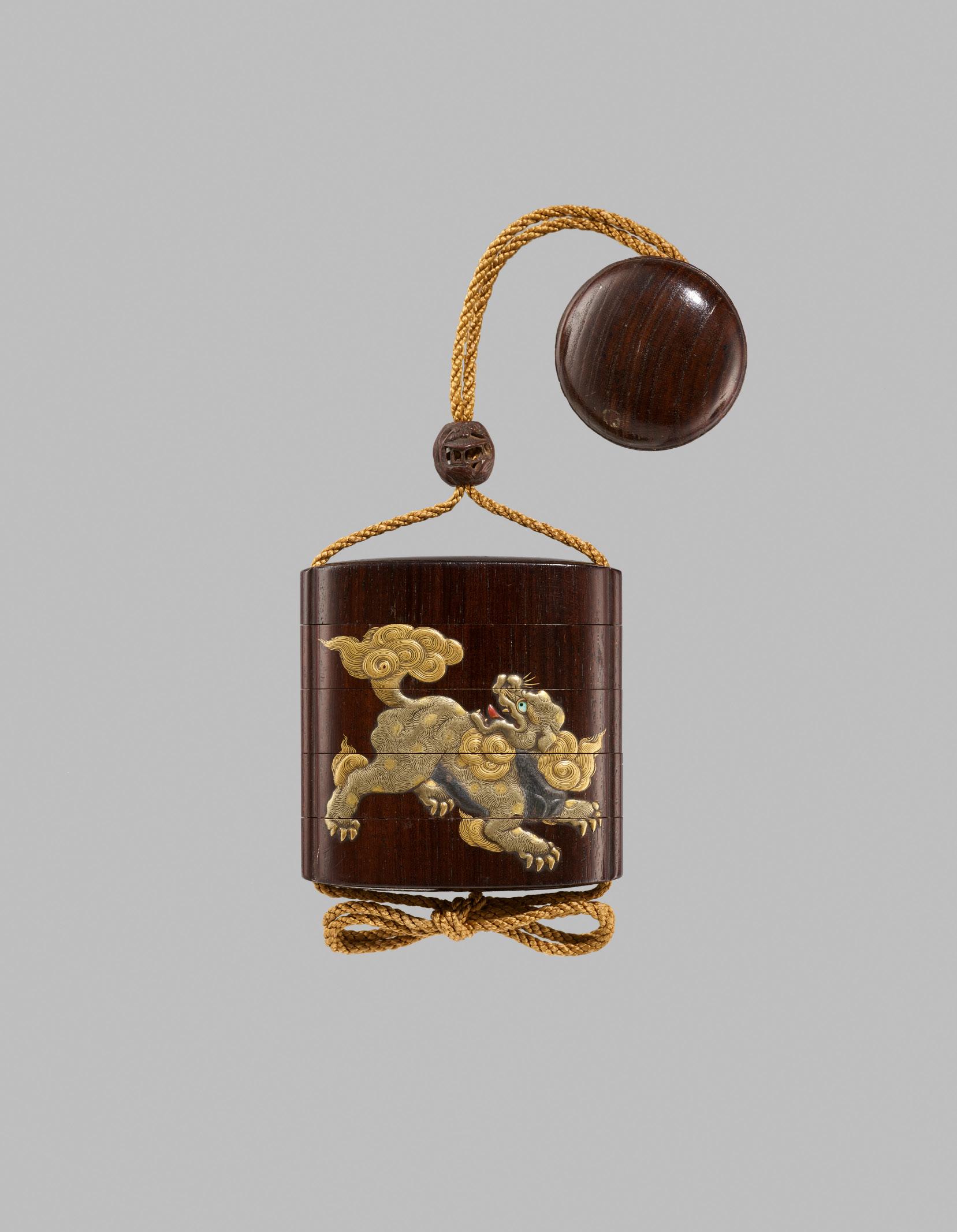
50 KAJIKAWA: A SUPERB FIVE-CASE GOLD LACQUER INRO WITH MINOGAME DESIGN AND WITH EN SUITE NETSUKE
By a member of the Kajikawa family, signed Kajikawa 梶川 saku 作 Japan, 19th century, Edo period (1615-1868)
Of upright shape and oval section, bearing a beautifully lustrous kinji ground, lacquered in gold takamaki-e and hiramaki-e with a design of four minogame and one young not having fully developed its seaweed tail yet, their carapaces realistically rendered and eyes inlaid. Signed underneath KAJIKAWA saku [made by Kajikawa]. The interior cases of nashiji with gold fundame rims.

With a coral ojime and beautifully matching square two-part manju netsuke depicting a minogame on a craggy rock, the rock with some fine kirigane detailing, the interior of nashiji and with silver rims. Signed to the underside Koju 光寿 Sei 製 [made by Koju]. According to E. A. Wrangham the artist made inro for the shogunate.
HEIGHT 9.3 cm, LENGTH 4.8 cm SIZE (the netsuke) 3.8 cm x 3.8 cm
Condition: The inro with some minor losses along the edges of the cases. The netsuke with a fine crack to the upper area and with some typical losses to the kirigane flakes. Both inro and the netsuke generally presenting well.
Provenance: A noted private collection, assembled by the previous owner’s great-grandfather and thence by descent. With old collection labels to the interior of the top case.
Estimate EUR 5,000
Starting price EUR 2,400
70
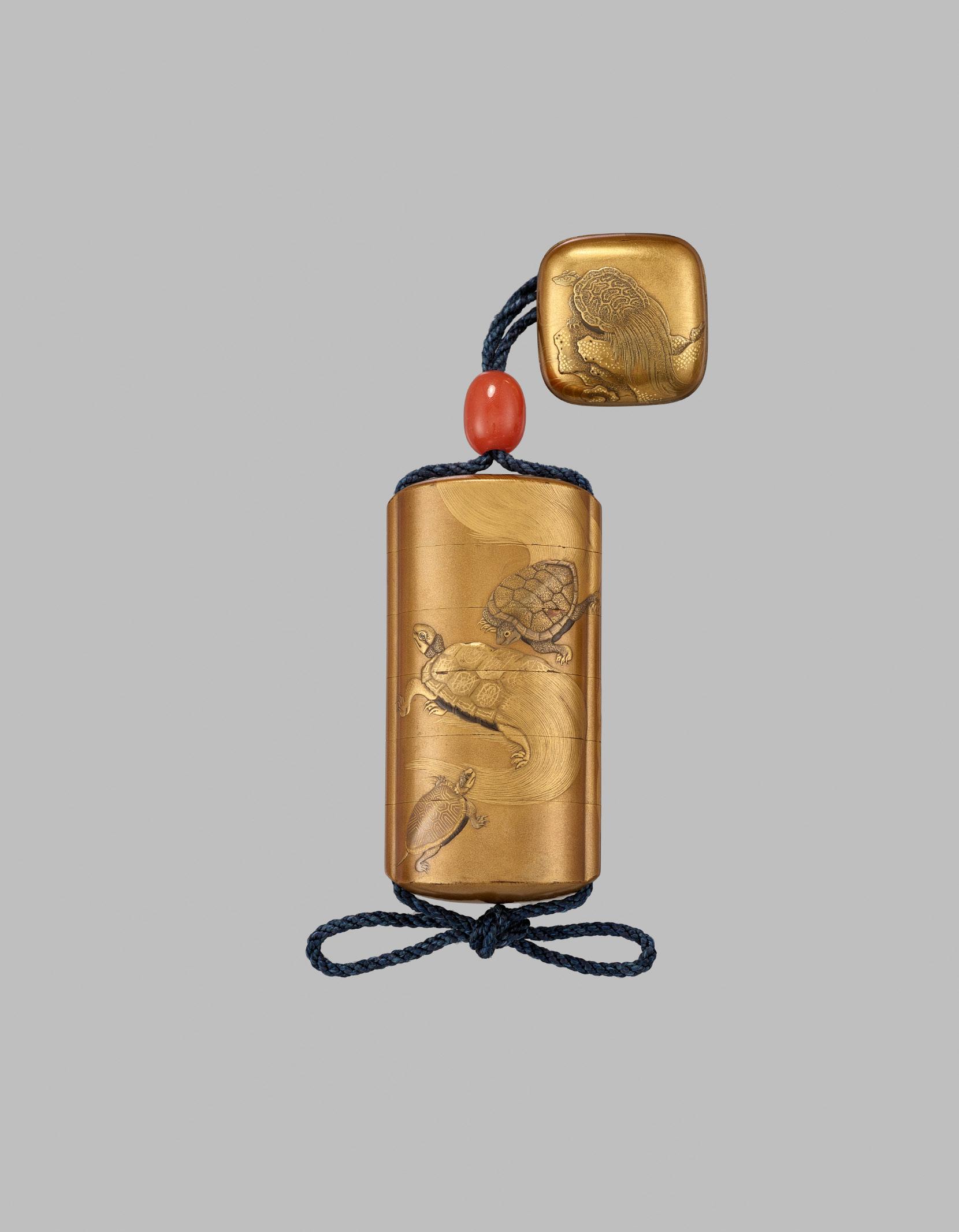
RYUSAI: A SUPERB SINGLE-CASE LACQUER INRO DEPICTING THE SANSUKUMI
By Ryusai,
signed Ryusai 柳哉 Japan, 19th century, Edo period (1615-1868)
The large single-case inro bearing a beautiful gyobu-nashiji ground, decorated in iro-e takamaki-e with an imposing snake coiling around the composition and around the large, warty toad to the other side, its skin masterfully emulated with light sprinkles of gold and silver. Signed underneath in gold lacquer RYUSAI. The interior of red lacquer. With a roiro-lacquered ojime.
HEIGHT 9 cm, LENGTH 6.8 cm
Condition. Very good condition with only very minor, typical wear to lacquer.
The toad is depicted with its mouth full, presumably having halfswallowed a snail, thus completing the trinity of the sansukumi; the frog, snake, and snail. Sansukumi translates to ‘the three who are afraid of one another’. The three animals are in a state of mutually assured destruction: the snake will consume the frog, however the frog has already eaten a poisonous snail, so the snake must perish as well. This motif is connected to sansukumi-ken, a category of Japanese hand games played by using three hand gestures. The
oldest sansukumi-ken game is mushi-ken, a game originally from China. In mushi-ken, the ‘frog’ represented by the thumb wins against the ‘slug’ represented by the pinkie finger, which, in turn defeats the ‘snake’ represented by the index finger, which wins against the ‘frog’. Although this game was imported from China, the Japanese version differs in the animals represented. In adopting the game, the original Chinese characters for centipede or millipede were apparently confused with the characters for the ‘slug’. The centipede was chosen because of the Chinese belief that the centipede was capable of killing a snake by climbing and entering its head. One of the few surviving sansukumi-ken games is jan-ken, which was brought to the West in the 20th century as rock paper scissors.
Literature comparison: For an inro with the same design by Kansai (presumably Koma Kansai), see Kurstin, Joe (1999) Miniature Masterpieces: The Storytelling Art of Japanese Inro, pp. 72-73.
AUCTION COMPARISON
Compare a related inro bearing a similar ground and with a similar design of snakes, at Christie’s, Arts of Japan, 5 December 2017, London, lot 38 (sold for GBP 16,250).


Estimate EUR 10,000
Starting price EUR 5,000
72
51

SEKIFU: A FINE TWO-CASE LACQUER INRO DEPICTING CRABS ON THE SHORESIDE


 By Sekifu, signed Sekifu 石風 saku 作 Japan, 19th century, Edo period (1615-1868)
By Sekifu, signed Sekifu 石風 saku 作 Japan, 19th century, Edo period (1615-1868)
Of short, rectangular form, the dense nashiji ground decorated with takamaki bamboo sprouts and a single crab on the shore detailed with kirigane flakes, the current of the water highlighted with hiramaki-e. The reverse with a small and large crab on the shoreside with delicately detailed grass in hiramaki-e; each crab has one thick pincer clamped while the other is opened. Signed underneath in gold lacquer SEKIFU saku [made by Sekifu]. The interior cases of nashiji with gold fundame rims.
HEIGHT 5.7 cm LENGTH 7.9 cm
Condition: Very good condition with minor wear, typical losses to the kirigane, and light rubbing.
Provenance: From the collection of ViceAdmiral Edgar Humann, and thence by descent in the same family. Edgar Eugène Humann (1838-1914) was a French naval officer who rose through the ranks to Admiral. In 1892, he was placed in command of the Far East naval division. From 1894 to 1895, he served as Chief of Staff of the French Navy, and in 1898, he was made Inspector General and Grand Officer of the Legion of Honor. He retired from active duty in May 1903.

LITERATURE COMPARISON
Compare a related inro depicting fish jumping swimming near the shoreside, signed Sekifu, illustrated in Lazarnick, George (1981) Netsuke & Inro Artists, and How to Read Their Signatures, vol. 2, p. 929.
Estimate EUR 2,500
Starting price EUR 1,200
74 52
Rear Admiral Edgar Humann (18381914) on the cover of Le Petit Journal, 29 July 1893
A RARE TWO-CASE LACQUER INRO DEPICTING THE IMMORTAL ROKO RIDING A MINOGAME
Unsigned Japan, 18th century, Edo period (1615-1868)
The unusual circular two-case inro bearing a stunning nashiji ground and lacquered in gold and silver takamaki-e and hiramaki-e, with some red lacquer and kirigane, depicting the Chinese immortal Roko riding on a minogame, amid swirling waves, and feeding a fish to the dragon-headed and seaweed-tailed mythical animal. The verso with a large kirigane-detailed, craggy rock amid further waves. The interior cases of nashiji with gold fundame rims.


HEIGHT 6 cm, LENGTH 6.4 cm
Condition: Very good condition with minor typical wear. Some light bruising to the top of the top case and to the bottom of the bottom case.
Provenance: Lempertz, 25-26 November 1994, Cologne, lot 1073. A private collection in Munich, Germany, acquired from the above.
Estimate EUR 2,500
Starting price EUR 1,200
75 53
YASUCHIKA: A RARE MIXED METAL TWO-CASE INRO WITH BUTTERFLIES AND ASAGAO (MORNING GLORY)
 By Tsuchiya Yasuchika V (1787-1852), signed Yasunobu 安信 Japan, 19th century, Edo period (1615-1868)
By Tsuchiya Yasuchika V (1787-1852), signed Yasunobu 安信 Japan, 19th century, Edo period (1615-1868)
Published: E. A. Wrangham, The Index of Inro Artists, Harehope, Northumberland, 1995, p. 324, EW 1995 (only the signature illustrated)
Of rounded rectangular form and oval section, the two-case inro in shibuichi decorated in gold, silver, copper, and shakudo takazogan with asagao (morning glory) and butterflies. The interior compartments in silver. With a fine shibuichi ojime carved with a bird with wings spread and incised gold highlights.
HEIGHT 6 cm, LENGTH 3.8 cm
Condition: Excellent condition with only minor typical wear.
Provenance: Phillips, London, 1989, purchased by Edward A. Wrangham, collection, no.1955. Sold at the latter’s fifth sale, Bonhams, London, 5 November 2014, lot 194. Edward A. ‘Ted’ Wrangham (1928-2009) formed one of the most important collections of Japanese Art in modern times. His reference book ‘The Index of Inro Artists’ (1995) is considered one of the most important English-language studies on Japanese lacquer ever published.
Tsuchiya Yasuchika V (H 11108.0) was the student of the fourth Yasuchika (H11107). He worked in a combination of the late Mito styles and the late Edo kinko styles.
Estimate EUR 1,500
Starting price EUR 800

76 54
Edward ‘Ted’ Wrangham with Her Majesty Queen Elizabeth II, 1980
A RARE INLAID AND LACQUERED KIRI WOOD SINGLE-CASE INRO DEPICTING CHRYSANTHEMUM FLOWERS
Unsigned Japan, 19th century, Edo period (1615-1868)


The ingot-shaped, Rinpa-style single-case inro finely carved from a choice piece of paulownia (kiri) wood and decorated with chrysanthemums (kiku) borne on leafy stems. The stems made of gold takamaki-e and the leaves of red lacquer, gold, and pewter (mitsuda) as well as mother of pearl and antler inlays, some leaves with gold hiramaki-e veins. The wood is of a rich, attractive grain. The interior lacquered in lustrous, black roiro.
HEIGHT 5.5 cm, LENGTH 10.2 cm
Condition: Good condition with minor wear and rubbing, and a minor loss with associated repair to one of the ringed cord holes.
Provenance: From an old private collection in France. The interior and exterior with old collector’s numbers, ‘No. 39.’
Estimate EUR 1,500
Starting price EUR 800
77 55
A page from Ehon Tsuhashi, showing Tekkai sennin in a similar pose. The inscription reads: Tekkai Sensei (Teacher)
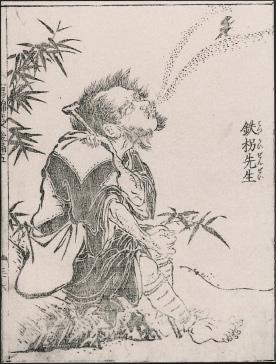
KOMATSU MITSUKATA: A RARE
TWO-CASE EBONY WOOD INRO DEPICTING GAMA AND TEKKAI SENNIN
 By Komatsu Mitsukata, signed Komatsu Mitsukata 小松光方 Japan, c. 1800, Edo period (1615-1868)
By Komatsu Mitsukata, signed Komatsu Mitsukata 小松光方 Japan, c. 1800, Edo period (1615-1868)
Of rounded rectangular form, carved intricately to each side of the naturalistically textured bark of ebony with a sennin under a thick gnarled pine tree, one side depicting Gama sennin talking in an animated manner to his large toad, the sennin wearing a loose-fitting robe with billowing sleeves, his face in a grimace as he conjures an incantation. The reverse with Tekkai sennin seated on a craggy rock holding on to his cane, his head turned to the side, the face with an intense expression and puffed cheeks as he exhales his soul in the form of a small figure trudging dutifully along in midair, suspended in a cloud-scroll vapor trail. The base incised with the signature KOMATSU MITSUKATA – little known is known about this artist, who appears to have made mostly fine wood inro carved from shitan or ebony and working in the Iwami style.

HEIGHT 8.5 cm, LENGTH 6.7 cm
Condition: Good condition with minor wear and miniscule nibbling along the edges of the risers. One small loss to the side of the top case.
LITERATURE COMPARISON
For a related three-case inro by Komatsu Mitsukata carved in shitan with a tiger under a pine tree to one side and a horse drinking from a river watched by a monkey to the other, see Ducros, Alain (1994) Paris Edo, no. 42.
Estimate EUR 5,000
Starting price EUR 2,400
A two-case inro of plum wood by Komatsu Mitsukata carved with two minogame on a rocky outcrop above crashing waves to one side, and two snakes with a pine tree to the other, was recently offered by Rosemary Bandini Japanese Art
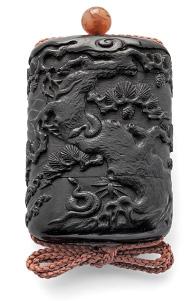
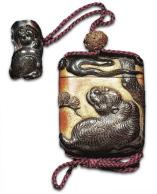
78 56
A FINE EBONY WOOD AND TSUIKOKU THREE-CASE INRO WITH EN SUITE OJIME AND NETSUKE
Unsigned Japan, 18th-19th century, Edo period (1615-1868)


Finely carved and worked in tsuikoku (carved black lacquer), depicting on one side two boys admiring a fishbowl, a net by their side, the verso showing a third boy playing with a spinning top, all set against a fine manji-diapered ground, and further with blooming chrysanthemums (kiku) enriching the composition, the top and bottom with further finely carved floral designs. With an en suite gilt metal ojime, also bearing a manji-diapered design, and with a matching two-part manju netsuke decorated with a boy pointing at a dragonfly and with further kiku flowers.
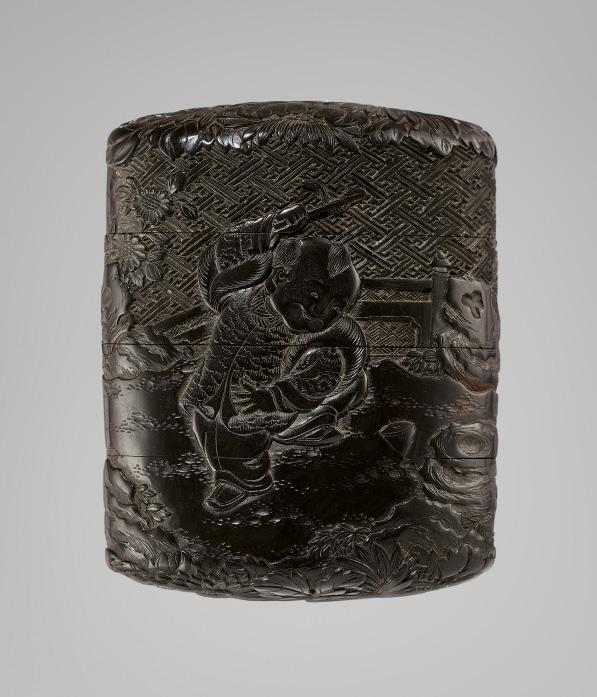
HEIGHT 6 cm, LENGTH 4.8 cm
DIAMETER (the netsuke) 3.3 cm
Condition: Excellent condition with only very minor typical wear.
Provenance: Old Swiss private collection. Old Japanese label to the interior of the top case and with a further old descriptive label reading: “Inro, carved wood, lacquered, one one side children in a garden with gold fish in a bowl, on the other a child and whipping top; three compartments, 2 1/2in. by 2 1/8 in.,”
Estimate EUR 2,500
Starting price EUR 1,200
79
57
A FINE THREE-CASE WOOD INRO OF A TORTOISE
Unsigned Japan, 19th century, Edo period (1615-1868)
Naturalistically carved as a tortoise with its limbs almost entirely retracted within its carapace, which is carved with finely detailed plates. The reptile has its head reared slightly to the right and the eyes are double inlaid in pale and dark horn. The underside shows the finely carved wrinkly and scaly clawed feet. The cord is hidden well within the tortoise’s carapace.
LENGTH 10.5 cm
Condition: Good condition with minor wear, natural flaws, traces of use, and a minor crack to the second case with associated old repairs.
Literature comparison: For a discussion of this type of inro, probably offered as 60th birthday gifts, see Kress, Heinze and Elise: Tortoise-shaped Wooden Inrō Carved by the Left-handed (左 = Hidari) Ichizan (Issan) 一山, Resident of Aizu (Wakamatsu), North of Fukushimain. In: International Netsuke Society Journal, Vol. 38, no. 4, Winter 2019, pp. 47-51.


AUCTION COMPARISON
Compare a near identical three-case wood inro of a tortoise, at Zacke, Fine Netsuke & Sagemono, 25 September 2020, Vienna, lot 281 (sold for 5,056).

Estimate EUR 4,000
Starting price EUR 2,000
80
58
A FINE WOOD TWO-CASE INRO DEPICTING HO-O BIRDS

Unsigned Japan, 18th-19th century, Edo period (1615-1868)
Finely carved in relief with a large ho-o bird to either side. Each with tall crests and exquisite plumage, soaring and diving amid scrolling clouds against a finely stippled and stained ground. Three exterior metal cord runners to each side.

HEIGHT 9.4 cm, LENGTH 5.9 cm
Condition: Very good condition with minor wear and traces of use to the interior
Provenance: From the collection of Donald Snow, Boston, Massachusetts, USA.
Estimate EUR 2,000
Starting price EUR 1,000
81 59
60 SANDOKU: A SUPERB SHIBAYAMA INLAID SINGLE-CASE WOOD INRO WITH A COCKATOO AND BUTTERFLIES
By Sandoku, signed Sandoku 三獨 Japan, Meiji period (1868-1912)
Finely inlaid with Shibayama-style inlays of mother-of-pearl, bone, and stained horn, with a pearl white cockatoo seated on a blossoming prunus branch. The other side with a delicate wisteria branch with iridescent butterflies flying around its white blossoms which hang delicately from the branches. The interior of the case fitted with a miniature shelf complete with sliding door cabinets, storage boxes, and drawers, inlaid with bone handles and dark stained wood.

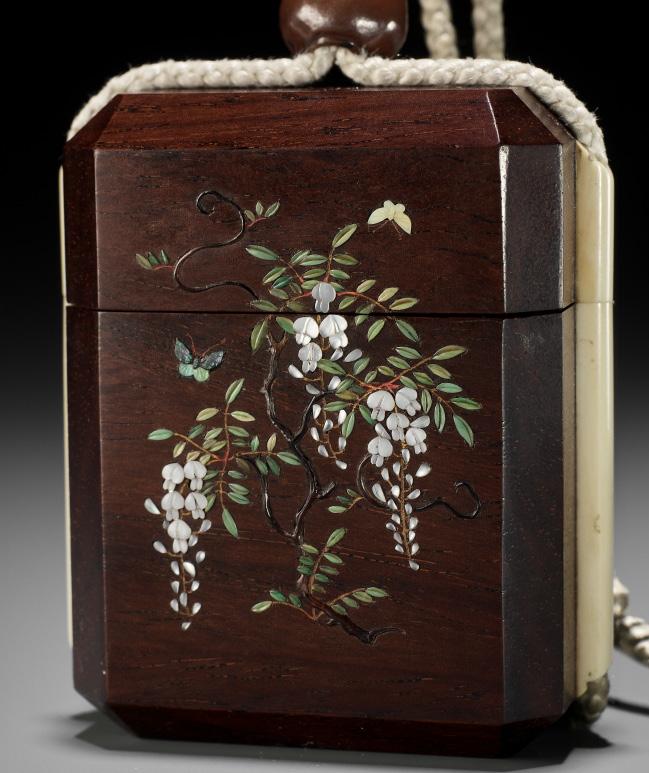
With an en suite wood mandarin duck (oshidori) netsuke attached to the end of the cord above a small daruma doll ojime with copper inlaid eyes and a hirazogan nyoi scepter to the back.
HEIGHT 6.6 cm, LENGTH 5.5 cm
LNEGTH (the netsuke) 4.1 cm
Condition: Excellent condition with only very minor wear. Provenance: Ex-collection of His Royal Highness Prince Henry, Duke of Gloucester (1900-1974), by repute.
Estimate EUR 5,000
Starting price EUR 2,400
82

83
ARMIN MÜLLER: A PORCELAIN (YAKIMONO) SAGEMONO SET OF A TWO-CASE INRO, NETSUKE AND OJIME
By Armin Müller (1932-2000), sealed Sui 水 Santa Barbara, California, USA, 1994
Of cylindrical shape, finely glazed in celadon green, the inro modeled as a section of bamboo with a few leaves and three ants crawling up the body, the individual nodes of the bamboo stalk cleverly incorporated as the cases. The similarly glazed ojime in the form of a frog perched on a bamboo node and the netsuke naturalistically modeled as a chasen (tea whisk). The inro, ojime, and netsuke signed with the artist’s single character seal signature Sui 水


HEIGHT (the inro) 8.2 cm
HEIGHT (the netsuke) 4.6 cm
Condition: Excellent condition.
Armin Müller (1932-2000) was an American contemporary netsuke artist who specialized in porcelain netsuke, inro, and ojime. A very moving tribute to Armin, written by David Carlin, was printed in the Fall 2000 issue of the INS Journal.
AUCTION COMPARISON
Compare a closely related porcelain sagemono set of a dragonfly amid aquatic plants and frogs by Armin Müller at Zacke, Fine Netsuke & Sagemono, 16 April 2021, Vienna, lot 325, (sold for EUR 1,952).
Estimate EUR 2,000
Starting price EUR 1,000
84 61
ARMIN MÜLLER: A PORCELAIN (YAKIMONO) SAGEMONO SET OF A TWO-CASE INRO, NETSUKE AND OJIME, KAPPA WITH MELONS
 By Armin Müller (1932-2000), signed Müller A.J 91 and sealed Sui 水 Santa Barbara, California, USA, 1991
By Armin Müller (1932-2000), signed Müller A.J 91 and sealed Sui 水 Santa Barbara, California, USA, 1991
Of cylindrical shape finely glazed in celadon green, the inro bearing a design of leaves, vines and melons on one side, and a tortoise, grasses and a dragonfly on the other side. The similarly glazed ojime modeled as a tortoise and the netsuke as a kappa with three melons. The inro signed MÜLLER and A.J. 91 and signed with the artist’s single character seal signature Sui 水. With the original wood tomobako (storage box), which shows the artist’s s seal as well.
HEIGHT (the inro) 4.9 cm
HEIGHT (the netsuke) 3.5 cm
Condition: Excellent condition.
Provenance: Ex-collection June Schuerch (1930-2000). With an old cardboard label reading “Kappa with Melons 1991 inro en suite: Armin Müller porcelain June Schuerch”.
Armin Müller (1932-2000) was an American contemporary netsuke artist who specialized in porcelain netsuke, inro, and ojime. A very moving tribute to Armin, written by David Carlin, was printed in the Fall 2000 issue of the INS Journal.
Estimate EUR 2,000
Starting price EUR 1,000
85 62
ARTIST SIGNATURES













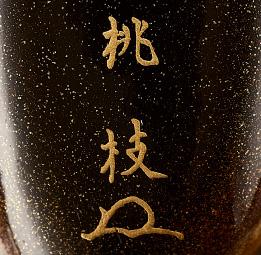
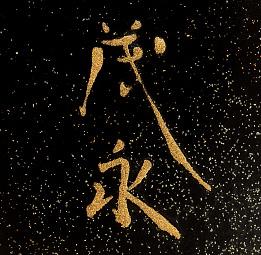



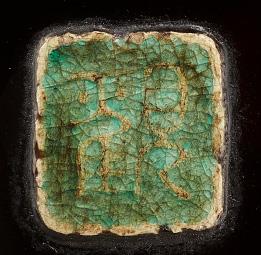

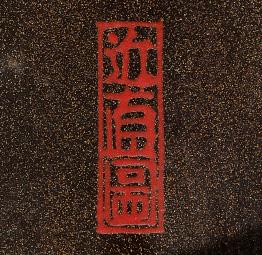




30 (the netsuke) Mitsuhiro 光廣 31 Moei 茂永 35 Toshi 花押 36 Kajikawa 梶川 38 Sekigawa 関川 39 Koma Koryu 古満巨柳 41 Kajikawa 梶川 42 Jokasai 常嘉齋 45 Hoyu 豊遊 47 Koma Sadahide 古満貞榮 48 Kanshosai 觀松齋 49 Jokasai 常嘉齋 50 Kajikawa 梶川 50 (the netsuke) Koju 光寿 51 Ryusai 柳哉 24 Zokoku 象谷 26 Kajikawa 梶川 27 Kan 観 29 Kan 観 & Kajikawa 梶川 30 Ritsuo 笠翁 9 Chikanao 近直 15 Yosei 楊成 16 Soshu 宗守 19 Toyosai 桃葉斎 20 Yoyusai 羊遊斎
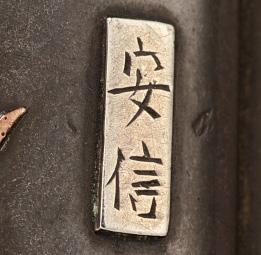



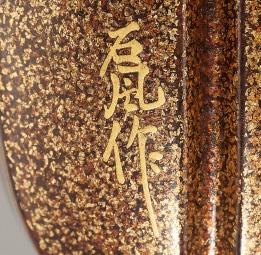

 62 Armin Müller
52 Sekifu 石風
54 Yasunobu 安信
56 Komatsu Mitsukata 小松光方
60 Sandoku 三獨
61 Armin Müller
62 Armin Müller
52 Sekifu 石風
54 Yasunobu 安信
56 Komatsu Mitsukata 小松光方
60 Sandoku 三獨
61 Armin Müller
IMPRINT
Publisher
Galerie Zacke founded 1968 © SZA Versteigerungen & Vertriebs GmbH
Sterngasse 13
1010 Vienna
Austria, Europe
Tel (0043-1) 532 04 52
Email: office@zacke.at
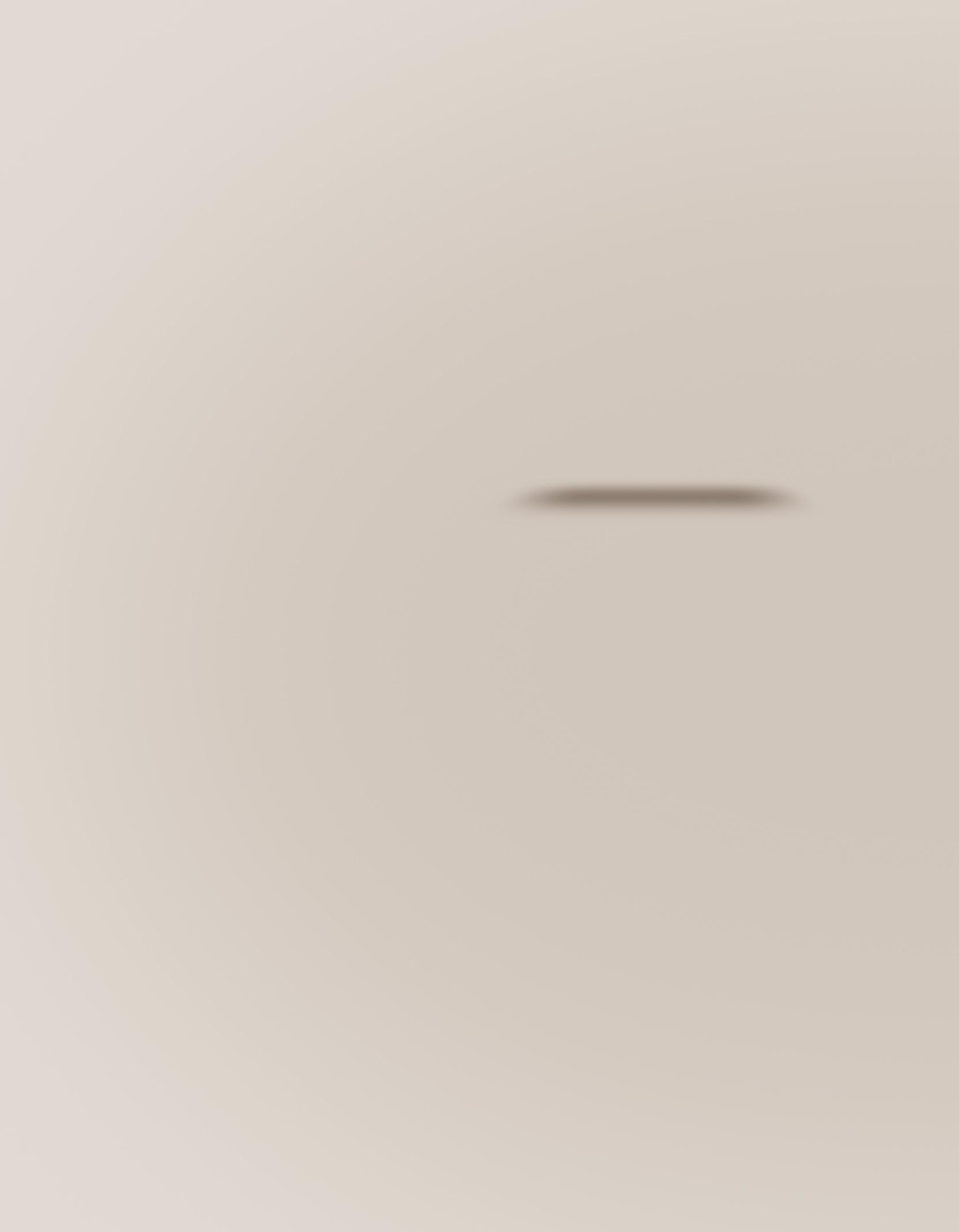
Editors
Lukas Zacke
Marion Schor

Expert
Lukas Zacke
Catalogers
Craig Anthony Harris
Ananya Casius
Assistance
Mieko Gray
Anna-Maria Pollmann
Photography
Georg Bodenstein
Design
Hermann Kienesberger
Printing Print Alliance
HAV Produktions GmbH
Website www.zacke.at
© GALERIE ZACKE
Reproduction forbidden
How to Find Us
Our new address is Sterngasse 13, 1010 Vienna. We’re located in the heart of Vienna’s iconic first district, only a seven-minute walk away from the Stephansdom. Our new gallery is easily reachable by public transport or car.

SalztorgasseSalztorbrücke
Salzgries ObereDonaustr.
Wipplingerstr.Sterngasse
Marc-Aurel-Str.
HoherMarkt
Rotenturmstr.
Schwedenplatz
Stephansplatz
Bäckerstr.
Wollzeile
Schulerstr.
U1 U4 U1 U3
Graben
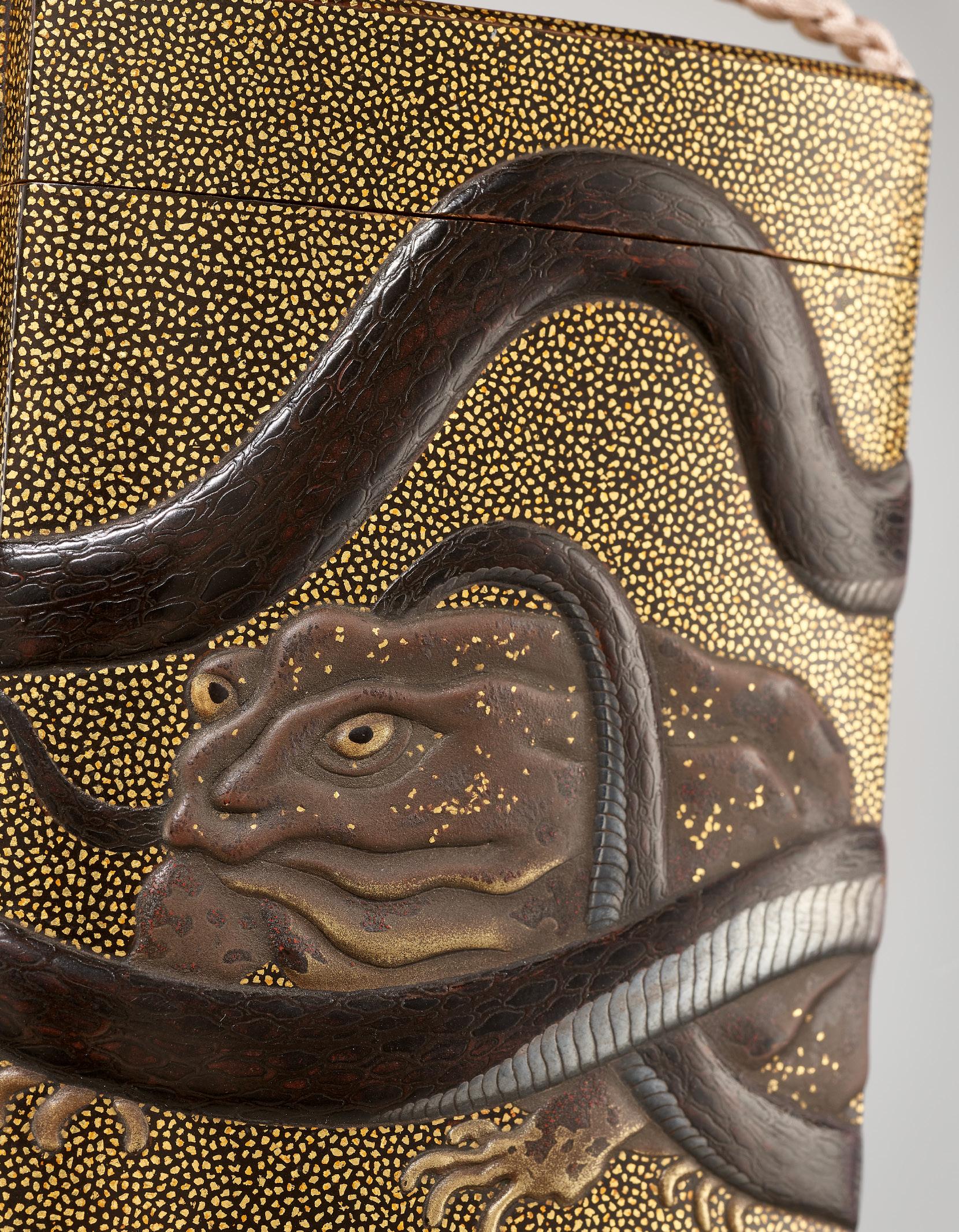

www.zacke.at 1010 VIENNA AUSTRIA STERNGASSE 13 Tel +43 1 532 04 52 . Fax +20 E-mail office@zacke.at






























 By Tsuishu Yosei, signed Yosei 楊成 zo 造 Japan, 17th-18th century, Edo period (1615-1868)
By Tsuishu Yosei, signed Yosei 楊成 zo 造 Japan, 17th-18th century, Edo period (1615-1868)




























 By Tamakaji Zokoku
By Tamakaji Zokoku
















 MITSUHIRO
By Mochizuki Hanzan (1743-1790), signed Ritsuo 笠翁 and kakihan Japan, 18th century, Edo period (1615-1868)
MITSUHIRO
By Mochizuki Hanzan (1743-1790), signed Ritsuo 笠翁 and kakihan Japan, 18th century, Edo period (1615-1868)

 By Nakaoji Moei, signed Moei 茂永 Japan, late 18th to early 19th century, Edo period (1615-1868)
By Nakaoji Moei, signed Moei 茂永 Japan, late 18th to early 19th century, Edo period (1615-1868)











 By Iizuka Toyo III, signed Toshi 花押 with kakihan Japan, c. 1800, Edo period (1615-1868)
By Iizuka Toyo III, signed Toshi 花押 with kakihan Japan, c. 1800, Edo period (1615-1868)






 By Koma Koryu, signed Koma Koryu 古満巨柳 Japan, 19th century, Edo period (1615-1868)
By Koma Koryu, signed Koma Koryu 古満巨柳 Japan, 19th century, Edo period (1615-1868)
































 By Sekifu, signed Sekifu 石風 saku 作 Japan, 19th century, Edo period (1615-1868)
By Sekifu, signed Sekifu 石風 saku 作 Japan, 19th century, Edo period (1615-1868)



 By Tsuchiya Yasuchika V (1787-1852), signed Yasunobu 安信 Japan, 19th century, Edo period (1615-1868)
By Tsuchiya Yasuchika V (1787-1852), signed Yasunobu 安信 Japan, 19th century, Edo period (1615-1868)



 By Komatsu Mitsukata, signed Komatsu Mitsukata 小松光方 Japan, c. 1800, Edo period (1615-1868)
By Komatsu Mitsukata, signed Komatsu Mitsukata 小松光方 Japan, c. 1800, Edo period (1615-1868)
















 By Armin Müller (1932-2000), signed Müller A.J 91 and sealed Sui 水 Santa Barbara, California, USA, 1991
By Armin Müller (1932-2000), signed Müller A.J 91 and sealed Sui 水 Santa Barbara, California, USA, 1991































 62 Armin Müller
52 Sekifu 石風
54 Yasunobu 安信
56 Komatsu Mitsukata 小松光方
60 Sandoku 三獨
61 Armin Müller
62 Armin Müller
52 Sekifu 石風
54 Yasunobu 安信
56 Komatsu Mitsukata 小松光方
60 Sandoku 三獨
61 Armin Müller




